Getac Technology 9213H Bluetooth for NoteBook PC User Manual 9213 User s Manual
Getac Technology Corp. Bluetooth for NoteBook PC 9213 User s Manual
Contents
- 1. User Manual 1
- 2. User Manual 2
User Manual 1
User’s Manual
(September 2008)
WARNING
Do not attempt to disassemble your notebook computer. Doing so may void
your warranty. There are no serviceable parts inside. Please refer all servicing
to a qualified personnel.
TRADEMARKS
The Bluetooth word mark and logos are owned by the Bluetooth SIG, Inc. All
brand and product names are trademarks or registered trademarks of their
respective companies.
NOTE
The information in this manual is subject to change without notice.

ENERGY STAR® is a government program that offers businesses and
consumers energy-efficient solutions, making it easy to save money while
protecting the environment for future generations.
Please reference ENERGY STAR® related information from
www.energystar.gov.
As an ENERGY STAR® Partner, MiTAC Technology Corporation has
determined that this product meets the ENERGY STAR® guidelines for
energy efficiency.
An ENERGY STAR® qualified computer uses 70 % less electricity than
computers without enabled power management features.
Earning the ENERGY STAR®
When every home office is powered by equipment that has earned the
ENERGY STAR®, the change will keep over 289 billion pounds of
greenhouse gases out of the air.
If left inactive, ENERGY STAR® qualified computers enter a
low-power mode and may use 15 watts or less. New chip
technologies make power management features more reliable,
dependable, and user-friendly than even just a few years ago.
Spending a large portion of time in low-power mode not only saves
energy, but helps equipment run cooler and last longer.
Businesses that use ENERGY STAR® enabled office equipment may
realize additional savings on air conditioning and maintenance.

Over its lifetime, ENERGY STAR® qualified equipment in a single
home office (e.g., computer, monitor, printer, and fax) can save
enough electricity to light an entire home for more than 4 years.
Power management (“sleep settings”) on computers and monitors can
result in much savings annually.
Remember, saving energy prevents pollution
Because most computer equipment is left on 24 hours a day, power
management features are important for saving energy and are an easy way
to reduce air pollution. By using less energy, these products help lower
consumers’ utility bills, and prevent greenhouse gas emissions.

i
Table of Contents
Preface ........................................................................................v
Notational Conventions.......................................................vi
Chapter 1 Getting Started...................................................1-1
Getting the Computer Running ............................................ 1-2
Unpacking ........................................................................ 1-2
Connecting to AC Power ................................................. 1-2
Opening the Cover ........................................................... 1-4
Turning On and Off the Computer................................... 1-4
Taking a Look at the Computer............................................ 1-6
Right-Side Components ................................................... 1-6
Left-Side Components ..................................................... 1-7
Front Components............................................................ 1-8
Bottom Components......................................................... 1-9
Top-open Components ................................................... 1-10
Where to Go from Here...................................................... 1-13
Chapter 2 Operating Your Computer.................................2-1
Starting and Stopping the Computer .................................... 2-2
Starting the Computer ...................................................... 2-2
Stopping the Computer .................................................... 2-2
Using the Quick Buttons ...................................................... 2-4
Using the Keyboard.............................................................. 2-5
Typewriter Keys............................................................... 2-5
Cursor-Control Keys ........................................................ 2-6
Numeric Keypad .............................................................. 2-6
Function Keys .................................................................. 2-7
Fn Key.............................................................................. 2-7

ii
Hot Keys .......................................................................... 2-8
Using the Touchpad ........................................................... 2-12
Configuring the Touchpad ............................................. 2-14
Using the DVD Drive (Optional) ....................................... 2-15
Inserting and Removing a Disc ...................................... 2-15
Installing an Optical Drive Dummy (Optional) ............. 2-17
Using the Video Features ................................................... 2-19
Configuring the Display Modes ..................................... 2-19
Using the Audio Features................................................... 2-20
Connecting Audio Devices ............................................ 2-21
Using the Communication Features ................................... 2-23
Using the LAN ............................................................... 2-23
Using the Wireless LAN ................................................ 2-24
Using the Bluetooth® Wireless Feature.......................... 2-27
Using the 3G Feature (Optional).................................... 2-31
Using the Fingerprint Sensor.............................................. 2-33
Chapter 3 Managing Power ................................................3-1
AC Adapter .......................................................................... 3-2
Battery Pack ......................................................................... 3-3
Charging the Battery Pack ............................................... 3-3
Initializing the Battery Pack............................................. 3-4
Checking the Battery Level.............................................. 3-5
Replacing the Battery Pack .............................................. 3-5
Installing a Second Battery Pack (Optional) .................... 3-7
Battery Low Signals and Actions..................................... 3-9
Power Management............................................................ 3-10
Hibernation..................................................................... 3-11
Power-Saving Tips ............................................................. 3-12
Chapter 4 Expanding Your Computer ...............................4-1
Connecting an External Monitor .......................................... 4-2
Connecting a USB Device.................................................... 4-3
Using ExpressCards ............................................................. 4-4
ExpressCard Type ............................................................ 4-4

iii
Inserting and Removing an ExpressCard ......................... 4-4
Using the Card Reader ......................................................... 4-6
Using the Port Replicator (Optional).................................... 4-8
Front Components............................................................ 4-8
Rear Components ............................................................. 4-9
System Memory Upgrade................................................... 4-12
Chapter 5 Using BIOS Setup..............................................5-1
When and How to Use BIOS Setup ..................................... 5-2
When to Use..................................................................... 5-2
Starting BIOS Setup......................................................... 5-2
Moving Around and Making Selections .......................... 5-4
Main Menu ........................................................................... 5-5
Advanced Menu ................................................................... 5-6
Security Menu ...................................................................... 5-7
Boot Menu............................................................................ 5-9
Exit Menu........................................................................... 5-10
Chapter 6 Installing Software Drivers and
Using the P1 Utility............................................6-1
How to Use the Driver Disc ................................................. 6-2
Installing Drivers.................................................................. 6-4
P1 Quick Button Utility........................................................ 6-6
Chapter 7 Caring for the Computer ...................................7-1
Protecting the Computer....................................................... 7-2
Using the Windows Security Center ................................ 7-2
Using the Cable Lock....................................................... 7-3
Taking Care of the Computer............................................... 7-4
Location Guidelines ......................................................... 7-4
General Guidelines........................................................... 7-4
Cleaning Guidelines ......................................................... 7-5
Battery Pack Guidelines................................................... 7-5
When Traveling.................................................................... 7-6

iv
Chapter 8 Troubleshooting.................................................8-1
Preliminary Checklist........................................................... 8-2
Solving Common Problems.................................................. 8-3
Battery Problems.............................................................. 8-4
Bluetooth Wireless Problems........................................... 8-4
DVD Drive Problems....................................................... 8-5
Display Problems ............................................................. 8-5
ExpressCard Problems ..................................................... 8-6
Hardware Device Problems.............................................. 8-7
Hard Disk Drive Problems ............................................... 8-7
Keyboard, Mouse, and Touchpad Problems .................... 8-8
LAN Problems ................................................................. 8-8
WLAN Problems.............................................................. 8-9
Power Management Problems........................................ 8-10
Software Problems ......................................................... 8-11
Sound Problems ............................................................. 8-11
Startup Problems ............................................................ 8-12
Other Problems............................................................... 8-13
Resetting the Computer...................................................... 8-14
Appendix A Specifications ...................................................A-1
Appendix B Regulatory Information ....................................B-1
On the Use of the System.....................................................B-2
Class B Regulations .........................................................B-2
Safety Notices ..................................................................B-3
On the Use of the RF Device................................................B-5
USA and Canada Safety Requirements and Notices........B-5
European Union CE Marking and Compliance Notices ..B-8
Index .........................................................................................I-1

v
Preface
This manual contains information that will help you operate the
computer. It is divided into 8 chapters, 2 appendices, and an index.
Chapter 1, Getting Started, takes you through the process of setting
up the computer and identifying its external components.
Chapter 2, Operating Your Computer, tells you how to use the
computer’s components and features.
Chapter 3, Managing Power, provides information on power.
Chapter 4, Expanding Your Computer, provides information on
installing and using peripheral devices.
Chapter 5, Using BIOS Setup, describes the BIOS Setup program
that configures the computer’s BIOS settings.
Chapter 6, Installing Software Drivers and Using the P1 Utilities,
describes how to install the drivers and utilities supplied with the
computer, as well as how to use the P1 quick launch key utility.
Chapter 7, Caring for the Computer, gives you tips in care and
maintenance.
Chapter 8, Troubleshooting, gives solutions to common problems
you may encounter when using the computer.
Appendix A, Specifications, gives a brief specification of the
computer.
Appendix B, Regulatory Information, provides regulatory
statements and safety notices on your computer.

vi
Notational Conventions
Throughout this manual, the following conventions are used to
distinguish elements of text.
NOTE: identifies additional information that requires special attention.
CAUTION: identifies important information that, if not followed, may result in loss of
data or damage to the computer.
Keyboard keys are shown in a bold typeset. For example:
Press the Enter key to complete.
When keys are joined by a plus sign (+), press the first key, and, while
keeping the first key down, press the remaining keys, finally release all
the keys. When necessary, keys are also shown in graphics.
A title, command, setup item, or button that you can see on the screen is
shown in boldface. A value or an option that you can select for a setup
item is shown in italic. For example:
Select When I press the power button, set it to Shut down, and
then click the Save changes button.

Getting Started 1-1
Chapter 1
Getting Started
Congratulations on purchasing this durable computer.
Your computer incorporates desktop computer capabilities into a
compact notebook-sized package. It can greatly enhance your
productivity either in the office or at home. And, of course, wherever you
need it, the computer is ready and easy “to go.”
This chapter first tells you step by step how to get the computer up and
running. You will find instructions for these procedures:
Unpacking
Connecting to AC power
Opening the cover
Turning on the computer
Turning off the computer
Then, you will find a section briefly introducing the external components
of the computer. And the last section navigates you to the information you
may need after the computer is ready for use.
CHAPTER

1-2 Getting Started
Getting the Computer Running
This section guides you through the procedures for getting the computer
ready for operation.
Unpacking
After unpacking the shipping carton, you should find these standard
items:
Notebook computer
Accessories:
− AC adapter
− AC power cord
− Driver disc
Inspect all the items. If any item is damaged or missing, notify your dealer
immediately.
Keep the shipping carton and packing materials in case you need to ship
or store the computer in the future.
Connecting to AC Power
The computer operates either on the external AC power or internal battery
power. It is suggested that you use AC power when you start up the
computer for the very first time.
CAUTION: Use only the AC adapter included with your computer. Using other AC
adapters may damage the computer.
1. Make sure that the computer is turned off.
2. Plug the DC cord of the AC adapter to the power connector of the
computer ().
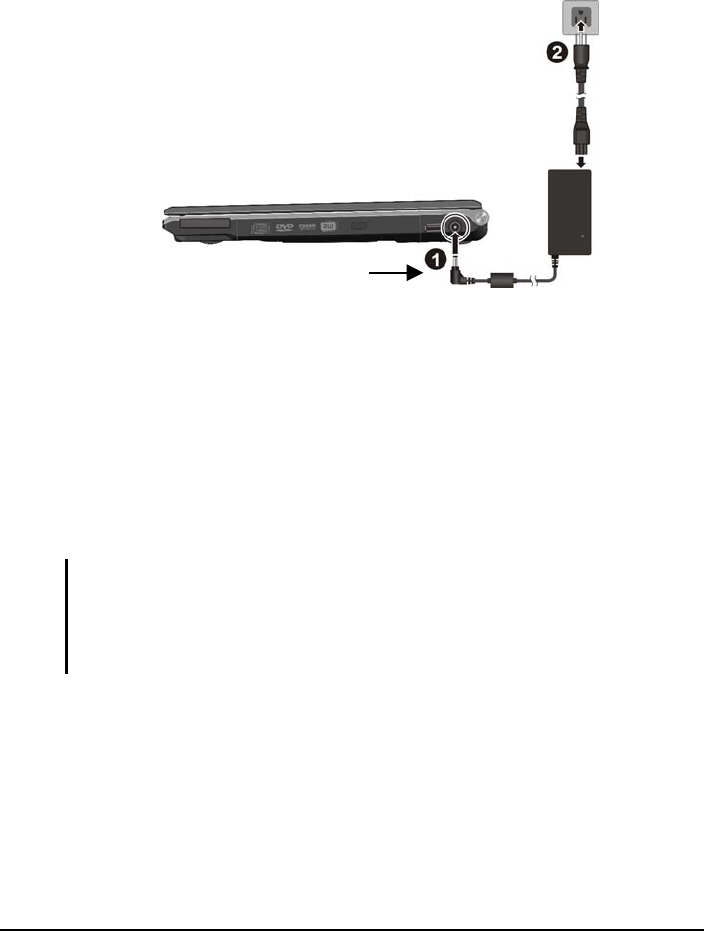
Getting Started 1-3
3. Plug the female end of the AC power cord to the AC adapter and the
male end to an electrical outlet ().
4. When the AC adapter is connected, power is being supplied from the
electrical outlet to the AC adapter and onto your computer. Now, you
are ready to turn on the computer.
5. When the AC adapter is connected, it also charges the battery pack.
The Battery Charge Indicator on the computer glows amber to
indicate that charging is in progress. When the battery is fully
charged, the Battery Charge Indicator is off. (For information on
using battery power, see Chapter 3.)
CAUTION:
When you disconnect the AC adapter, disconnect from the electrical outlet first and
then from the computer. A reverse procedure may damage the AC adapter or the
computer.
When unplugging the connector, always hold the plug head. Never pull on the cord.
Push twice to insert thoroughly
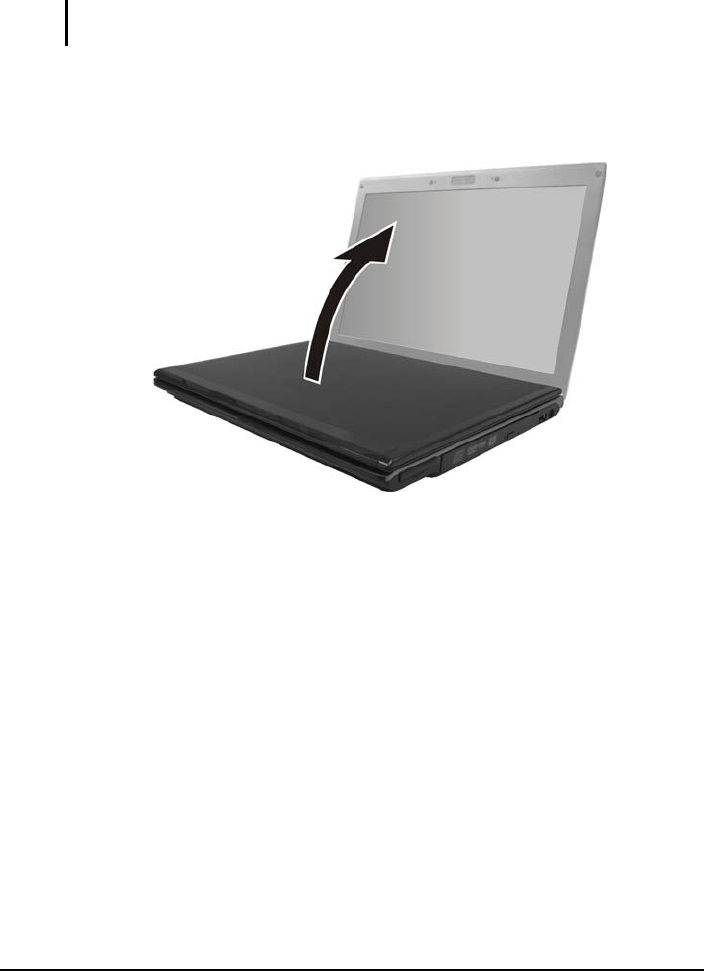
1-4 Getting Started
Opening the Cover
CAUTION: Be gentle when opening and closing the cover. Opening it vigorously or
slamming it shut could damage the computer.
Open the top cover by lifting up the cover. You can tilt the cover forward
or backward for optimal viewing clarity.
Turning On and Off the Computer
Turning On
1. Make sure that the computer is connected to AC power or the battery
is fully charged.
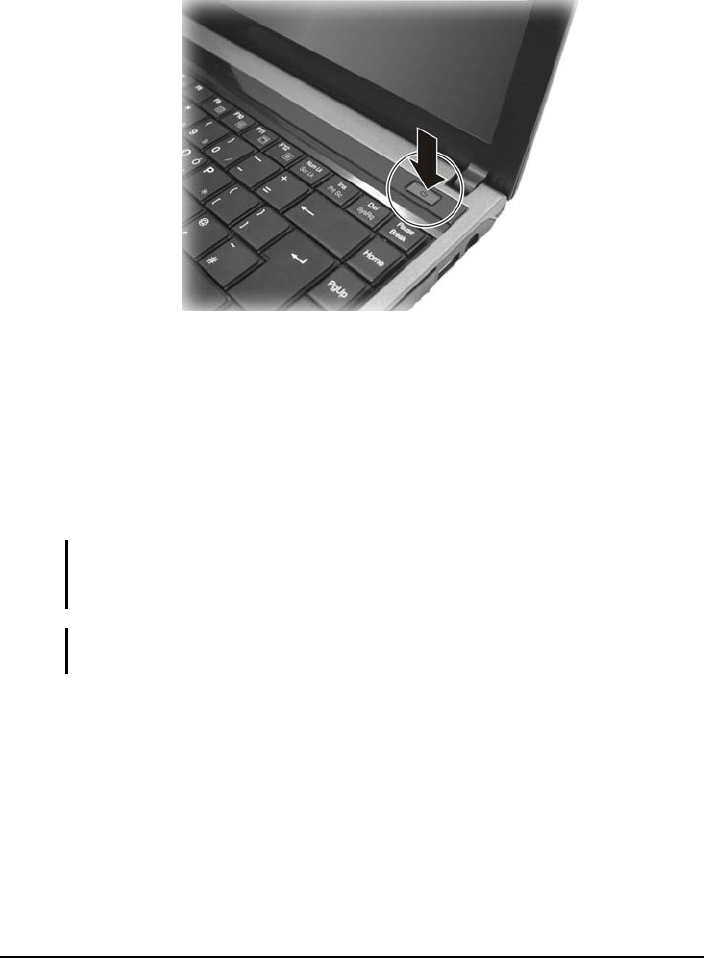
Getting Started 1-5
2. Press the power button.
3. Each time the computer is turned on, it performs a Power-On Self
Test (POST), and the Windows operating system should start.
Turning Off
To turn off the computer power, use the “Shut Down” command of your
operating system.
NOTE: There are other ways you can stop the computer so that you will be back to
where you left off when you next turn on the computer. (See “Stopping the Computer” in
Chapter 2 for information.)
CAUTION: If you have to turn the computer on again immediately after turning it off,
wait for at least five seconds. Turning the computer off and on rapidly can damage it.
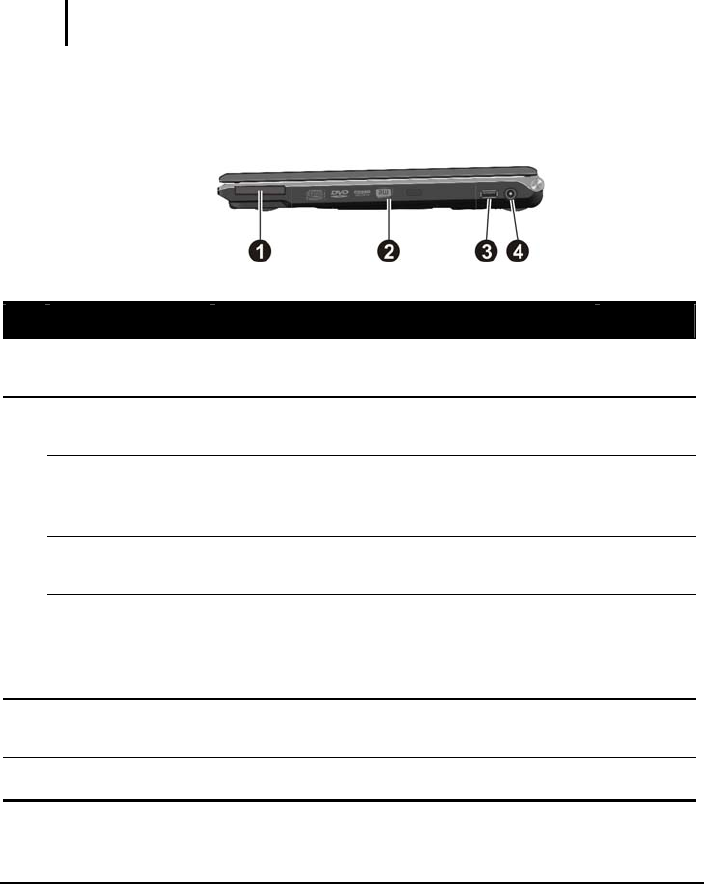
1-6 Getting Started
Taking a Look at the Computer
This section identifies the external components of the computer and
briefly describes the function of each component.
NOTE: Depending on the model you purchased, the appearance of your computer may
not be exactly the same as those shown in this manual.
Right-Side Components
Ref Component Description See Also
ExpressCard Slot Accepts an ExpressCard for additional
functions.
P. 4-4
Swappable Bay Depending on your model, the swappable bay
may contain any of the following:
DVD Super
Multi Drive Accepts a compact disc for installing or
loading software, accessing data, and playing
music/video.
P. 2-14
Secondary
Battery Pack Supplies power to your computer when
external power is not connected.
P. 3-7
Optical Drive
Dummy Install an optical drive dummy if you do not
plan to use the optical drive for a length of
time or to lighten the computer during
transport.
P. 2-17
USB Port Connects a USB device, such as a flash disk,
printer, digital camera, joystick, and more.
P. 4-3
Power Connector Connects the AC adapter. P. 1-2
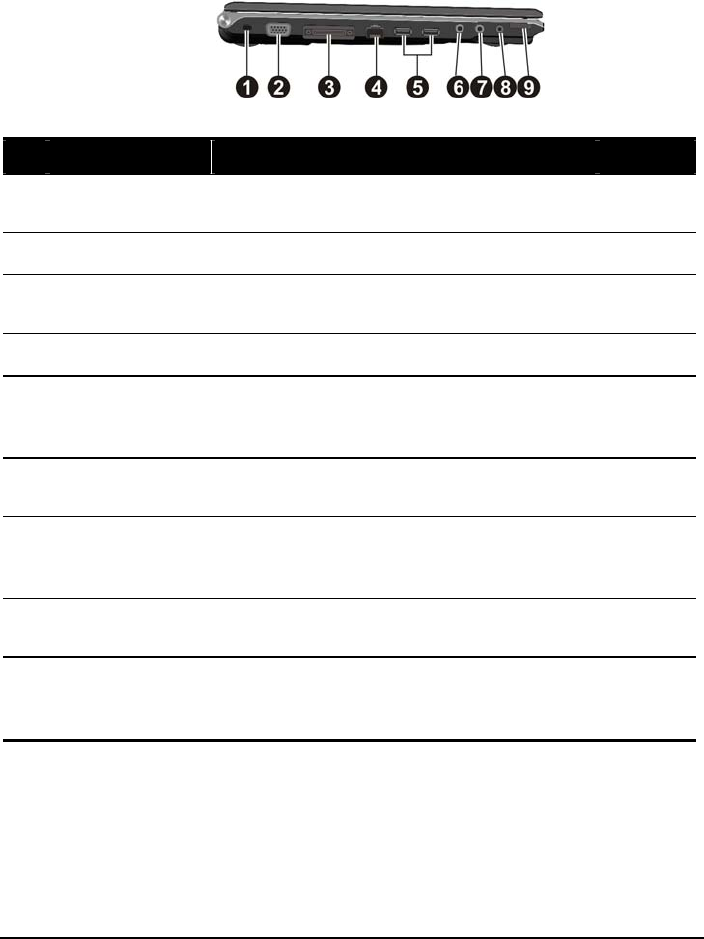
Getting Started 1-7
Left-Side Components
Ref Component Description See Also
Kensington Lock Locks the computer to a stationery object for
security.
P. 7-3
VGA Connector Connects an external display. P. 4-2
Expansion Bus
Connector Connects to a Port Replicator. P. 4-8
RJ-45 Connector Connects the LAN cable. P. 2-23
USB Ports Each of the two ports connects a USB device,
such as a flash disk, printer, digital camera,
joystick, and more.
P. 4-3
Microphone
Connector Connects an external microphone. P. 2-21
Audio Output
Connector Connects a set of headphones, external
speakers with amplifier, or an audio recording
device.
P. 2-21
S/PDIF
Connector Connects an S/PDIF device such as a digital
speaker set for digital audio output.
P. 2-21
RF (radio
frequency)
On/Off Switch
Serves as the master switch that allows you to
turn the wireless LAN radio, 3G, and
Bluetooth wireless feature.
P. 2-24,
2-27, 2-32

1-8 Getting Started
Front Components
Ref Component Description See Also
Card Reader Accepts a MultiMediaCard (MMC), Secure
Digital (SD), Memory Stick (MS) or Memory
Stick PRO (MS PRO) card for removable
storage media.
P. 4-6
SIM Card slot Contains the optional 3G SIM card. P. 2-31
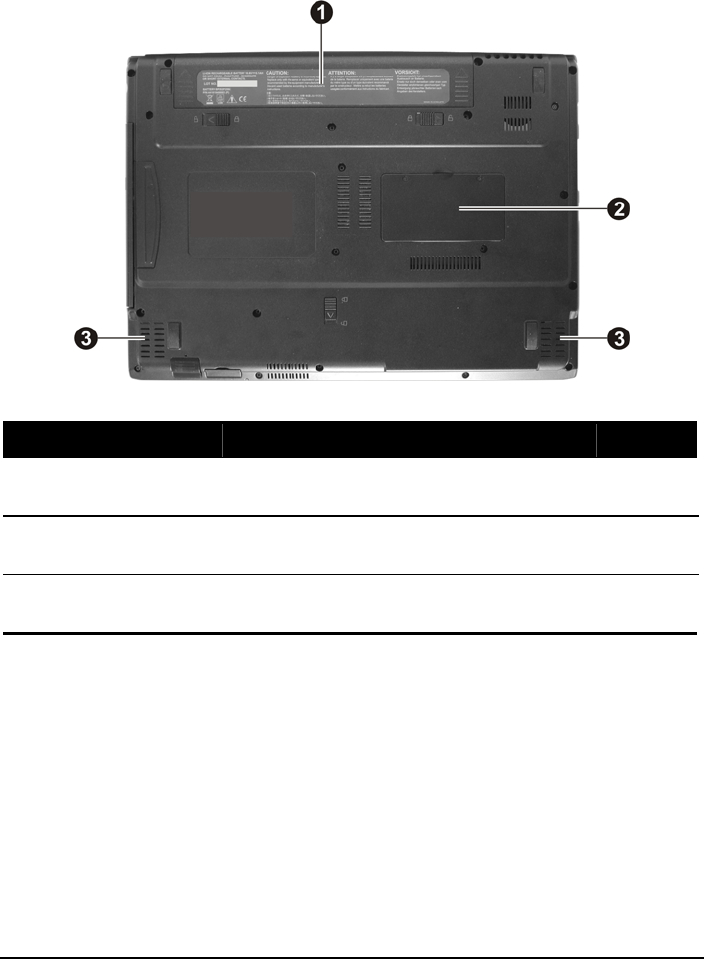
Getting Started 1-9
Bottom Components
Ref Component Description See Also
Battery Pack Supplies power to your computer when
external power is not connected.
P. 3-3
Memory Slot Inside is the memory slot for expanding the
memory size.
P. 4-12
Speakers Sends out sound and voice from the
computer.
P. 2-20
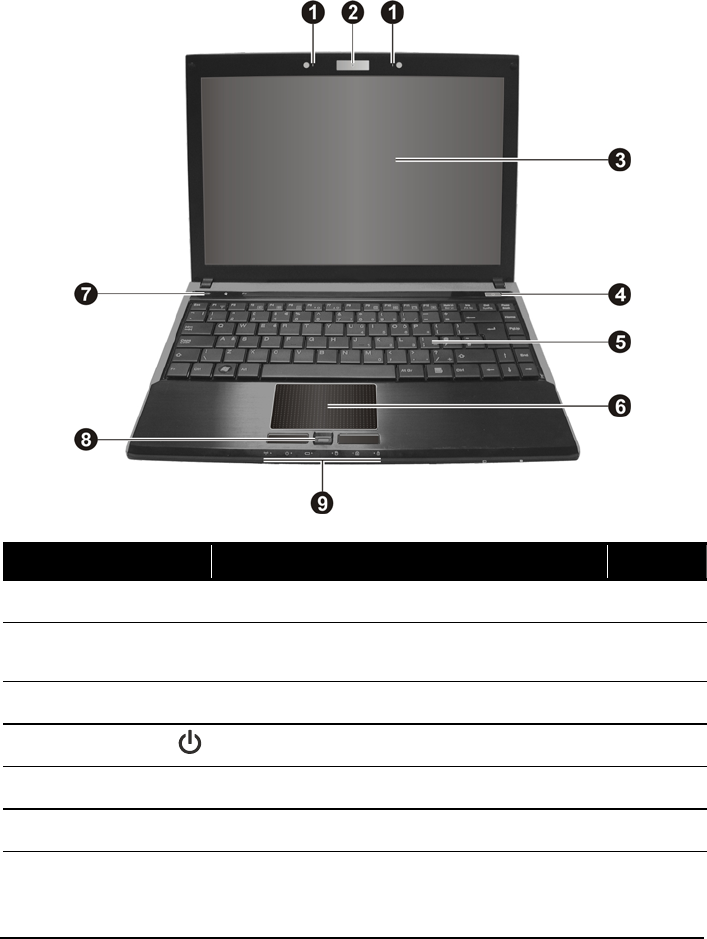
1-10 Getting Started
Top-open Components
Ref Component Description See Also
Microphone Receives sound and voice for the computer. P. 2-20
CMOS Camera
Lens Allows you to use your computer’s camera
function.
LCD Screen Displays the output of the computer. P. 4-2
Power Button Turns the computer power ON and OFF. P. 1-4
Keyboard Serves as the data input device of the computer. P. 2-5
Touchpad Serves as the pointing device of the computer. P. 2-12
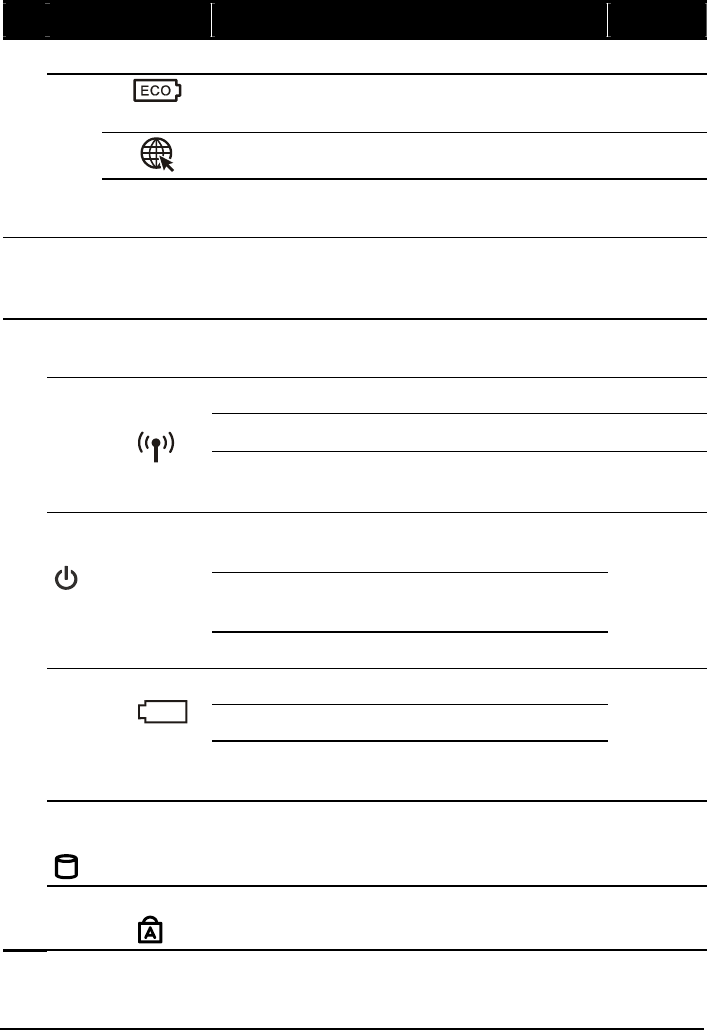
Getting Started 1-11
Ref Component Description See Also
Quick Buttons
Enables/disables power saving when using
battery power.
P. 2-4
Microsoft® Internet Explorer quick launch key. P. 2-4
P1 P1 (Program 1 – user customized) quick launch
key.
P. 2-27
Fingerprint
Sensor Serves as the fingerprint verification,
preventing unauthorized access to your
computer.
P. 2-31
Indicators Show the current status of the computer’s
devices.
Lights blue when WLAN radio is on. P. 2-24
Lights red when Bluetooth® feature is on. P. 2-27
WLAN /
Bluetooth®
indicator
Lights purple when both WLAN radio and
Bluetooth® feature is on.
Lights blue when computer is on and connected
to AC power.
Lights amber when computer is on and using
battery power.
AC / Battery
Power indicator
Blinks blue when computer is in Sleep mode.
P. 1-4
Lights blue when the battery is charged.
Lights amber when the battery is being charged.
Battery charge
indicator
Blinks red when the battery’s capacity is below
10 %.
P. 3-3
Hard disk drive
in-use indicator
Blinks blue when computer is accessing the
hard disk drive.
P. 2-14
Caps Lock
indicator
Lights blue when Caps Lock is on. P. 2-5

1-12 Getting Started
Ref Component Description See Also
Num Lock
indicator
Lights blue when Num Lock is on. P. 2-5

Getting Started 1-13
Where to Go from Here
As your computer is ready for operation, you may want to do any of the
following now:
For this purpose... Do this...
To know more about the computer... Go on to the next chapter.
To install the operating system if your
dealer has not already done so...
See the operating system manual.
To know more about the operating
system...
Read the operating system manual.
To install the drivers if your dealer has
not already done so...
See Chapter 6.
To charge the battery pack for the first
time...
See “Charging the Battery Pack” in
Chapter 3.

Operating Your Computer 2-1
Chapter 2
Operating Your Computer
This chapter provides information about the use of the computer.
If you are new to computers, reading this chapter will help you learn the
operating basics. If you are already a computer user but are new to
notebook computers, you may choose to read only the parts containing
information unique to your computer.
Described in this chapter are the operating basics of these components:
Starting and stopping the computer
Quick buttons
Keyboard
Touchpad
DVD drive
Video features
Audio features
Communication features
Fingerprint sensor
CHAPTER

2-2 Operating Your Computer
Starting and Stopping the Computer
There are a number of ways to start and stop the computer.
Starting the Computer
You always start the computer using the power button.
A computer starts up with an operating system (OS) existing on the
storage device such as the hard disk and optical disc. The computer will
automatically load the OS after you turn it on. This process is called
booting.
NOTE: An operating system is the platform for all your software application programs to
run on. Your computer uses the Microsoft Windows Vista operating system.
Stopping the Computer
When you finish a working session, you can stop the computer by turning
off the power or leaving the computer in Sleep or Hibernation mode:
To stop in
this mode... Do this... To start up or
resume again
Off Click Start Shut Down … . This can
prevent loss of unsaved data or damage to
your software programs.
If the system is locked up because of
hardware or software problems, press the
power button to turn off the computer.
Press the power
button.
Sleep Depending on your settings in Windows,
you can place the computer in Sleep
mode by:
• Closing the display cover
• Pressing the Fn+F12 hot key
• Pressing the power button
Press any key.

Operating Your Computer 2-3
To stop in
this mode... Do this... To start up or
resume again
Hibernation Depending on your settings in Windows,
you can place the computer in
Hibernation mode by:
• Closing the display cover
• Pressing the power button
Press the power
button.
If you choose to stop in Sleep or Hibernation mode, you can return to
where you left off the next time you start up the computer. (See “Power
Management” in Chapter 3 for more information.)
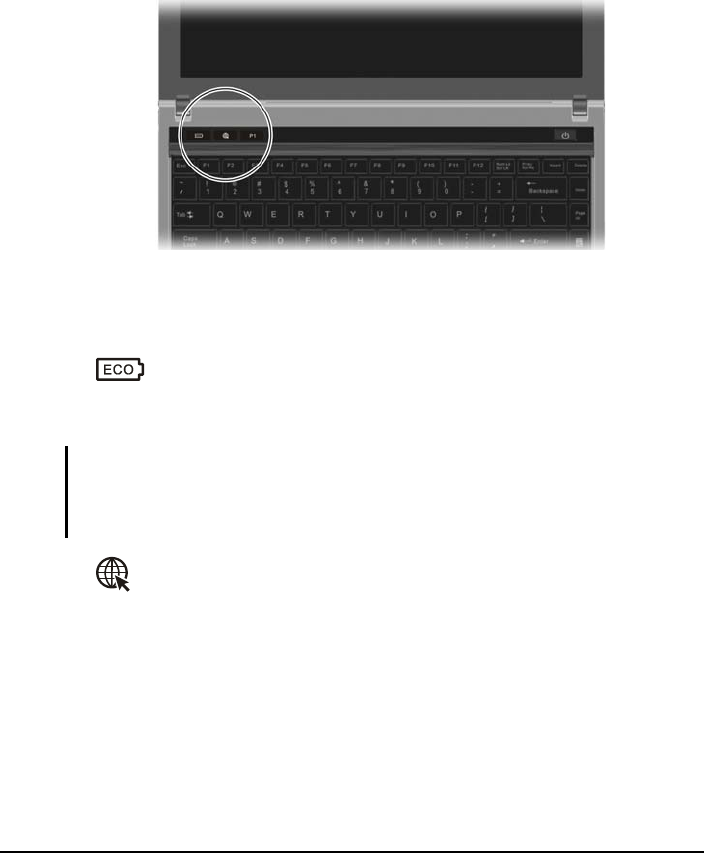
2-4 Operating Your Computer
Using the Quick Buttons
The Quick buttons are three pre-defined buttons located on the left above
the keyboard.
The Easy Start buttons allow you to start the frequently-used programs
with one single press of a button (from left to right):
Enter into power saving mode when using battery power.
The system will turn down the panel backlight and sacrifice
processing speed to gain more battery life.
NOTE:
The ECO button works only when using battery power.
Upon connecting AC power when in ECO mode, your computer will return to
previous state before power saving mode.
Microsoft® Internet Explorer
P1 P1 (Program 1 – user customized) quick launch key
(see chapter 6 for details)

Operating Your Computer 2-5
Using the Keyboard
Your keyboard has all the standard functions of a full-sized computer
keyboard plus a Fn key added for specific functions.
The standard functions of the keyboard can be further divided into four
major categories:
Typewriter keys
Cursor-control keys
Numeric keys
Function keys
Typewriter Keys
Typewriter keys are similar to the keys on a typewriter. Several keys are
added such as the Ctrl, Alt, Esc, and lock keys for special purposes. When
the lock keys (Caps Lock, Num Lk, and Scr Lk) are pressed, their
corresponding indicators light up.
The Control (Ctrl) / Alternate (Alt) key is normally used in combination
with other keys for program-specific functions. The Escape (Esc) key is
usually used for stopping a process. Examples are exiting a program and
canceling a command. The function depends on the program you are
using.
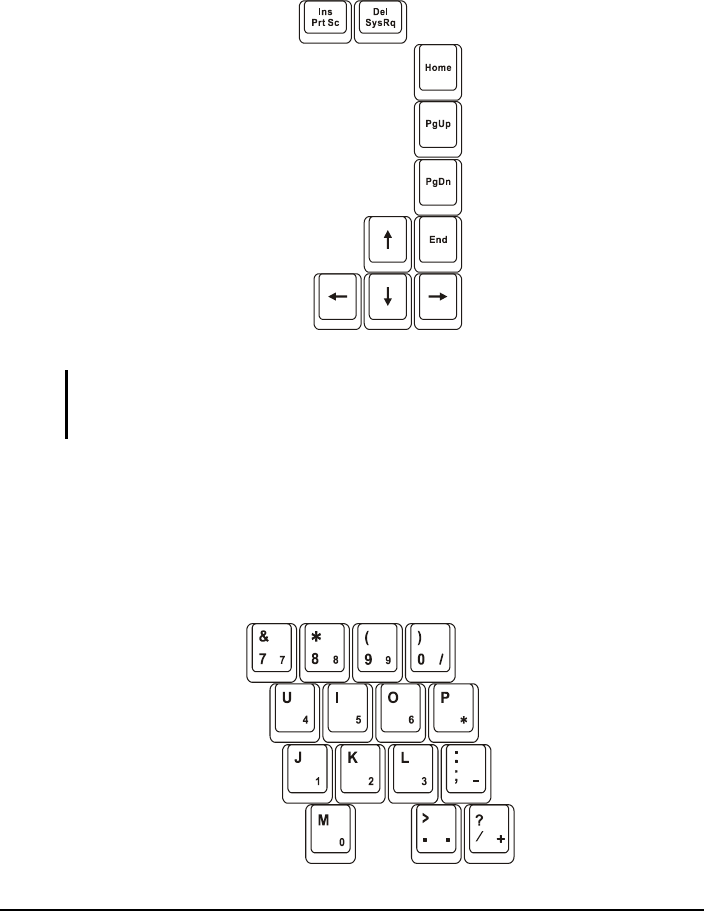
2-6 Operating Your Computer
Cursor-Control Keys
NOTE: The word “cursor” refers to the indicator on the screen that lets you know
exactly where on your screen anything you type will appear. It can take the form of a
vertical or horizontal line, a block, or one of many other shapes.
Numeric Keypad
A 15-key numeric keypad is embedded in the typewriter keys as shown
next:

Operating Your Computer 2-7
Numeric keys facilitate entering of numbers and calculations. When Num
Lock is on, the numeric keys are activated; meaning you can use these
keys to enter numerals.
NOTE:
When the numeric keypad is activated and you need to type the English letter in the
keypad area, you can turn Num Lock off or you can press Fn and then the letter
without turning Num Lock off.
Some software may not be able to use the numeric keypad on the computer. If so,
use the numeric keypad on an external keyboard instead.
Function Keys
On the top row of the keys are the function keys: F1 to F12. Function keys
are multi-purpose keys that perform functions defined by individual
programs.
Fn Key
The Fn key, at the lower left corner of the keyboard, is used with another
key to perform the alternative function of a key. The letter “Fn” and the
alternative functions are identified by the color of blue on the keytop. To
perform a desired function, first press and hold Fn, then press the other
key.
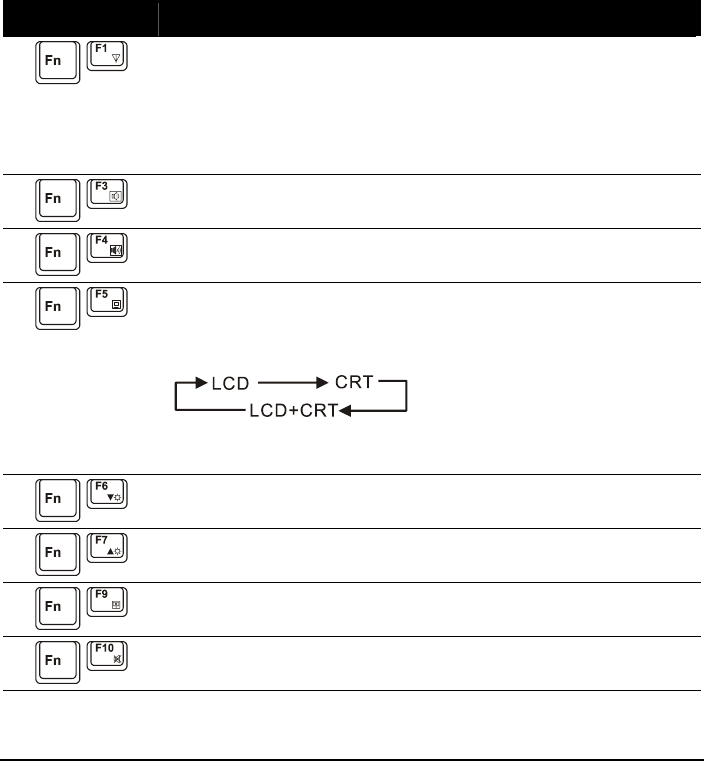
2-8 Operating Your Computer
Hot Keys
Hot keys refer to a combination of keys that can be pressed any time to
activate special functions of the computer. Most hot keys operate in a
cyclic way. Each time a hot key combination is pressed, it shifts the
corresponding function to the other or next choice.
You can easily identify the hot keys with the icons imprinted on the
keytop. The hot keys are described next.
Key Description
Switches the wireless LAN radio and/or Bluetooth® wireless
feature and/or 3G feature on and off.
NOTE: Refer to the next table for the behavior of Fn+F1 key in
relation to the availability of the wireless LAN module and/or
Bluetooth® module and/or 3G module in your computer.
Decreases the sound volume.
Increases the sound volume.
Switches the display output to one of the following when
external devices are connected.
Upon booting the system with CRT:
NOTE: This function only applies to Plug & Play display
devices.
Decreases the LCD brightness.
Increases the LCD brightness.
Switches the touchpad off and on (depending on your model).
Switches the system sound output off (mute) and on.

Operating Your Computer 2-9
Key Description
Switches LCD display on and off.
Serves as the sleep button that you can define with Windows’
Power Options. (See the “Power Management” in Chapter 3.)
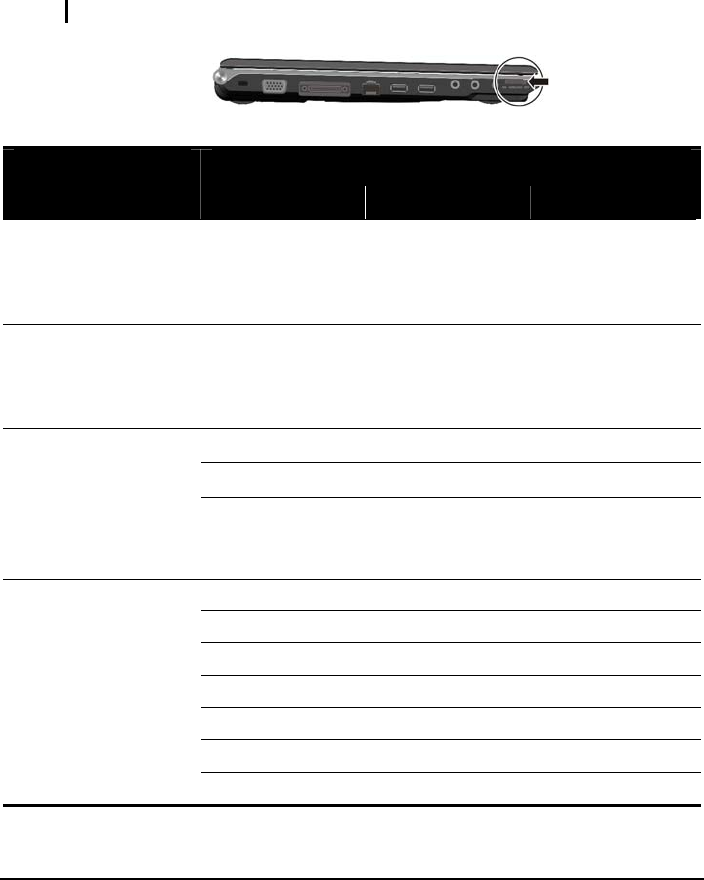
2-10 Operating Your Computer
Fn+F1 Behavior
The following table shows the behavior of Fn+F1 key in relation to the
availability of the wireless LAN module and/or Bluetooth® module
and/or 3G module in your computer.
NOTE: Make sure that RF switch is at the ON position.
Upon pressing Fn+F1 key . . .
Available Module Wireless LAN Bluetooth 3G
Wireless LAN
(only)
Default: wireless
LAN radio is ON.
OFF N/A
(not available)
N/A
Bluetooth® (only)
Default: Bluetooth®
wireless feature is
OFF.
N/A ON N/A
ON ON N/A
OFF ON N/A
Wireless LAN +
Bluetooth®
Default: wireless
LAN radio is ON,
Bluetooth® wireless
feature is OFF.
OFF OFF N/A
ON ON OFF
OFF OFF ON
OFF ON ON
OFF ON OFF
ON OFF ON
ON ON ON
Wireless LAN +
Bluetooth® + 3G
Default: wireless
LAN radio is ON,
Bluetooth® wireless
feature is OFF,
3G feature is OFF.
OFF OFF OFF
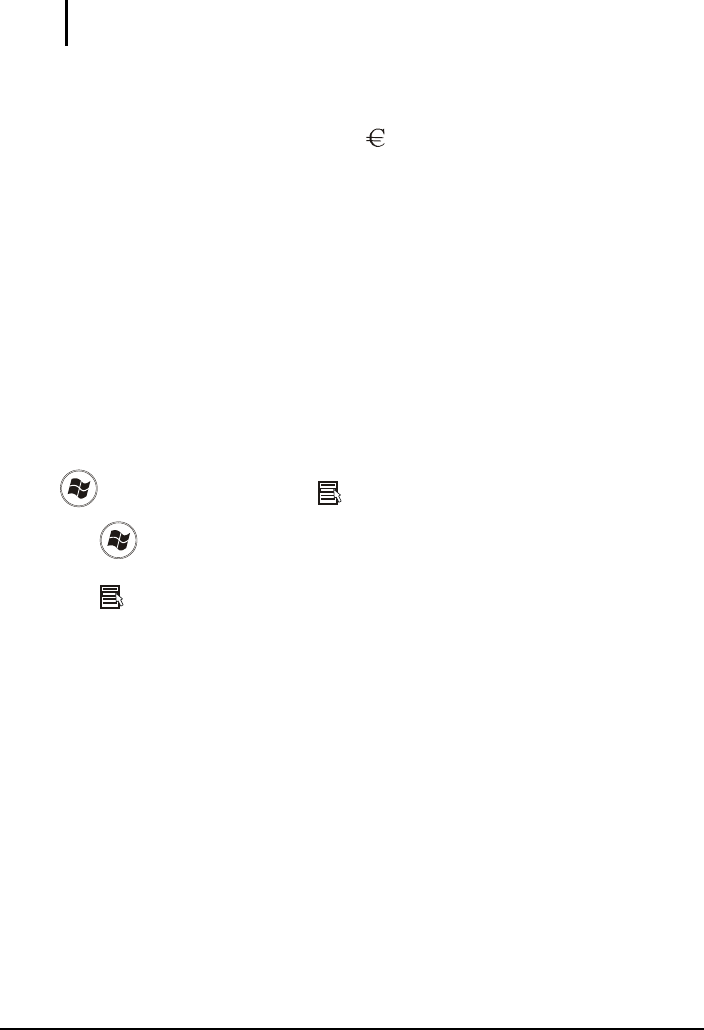
Operating Your Computer 2-11
NOTE: Upon restarting your computer or upon waking up from Sleep mode, the system
will resume Fn+F1 behavior based on the last state.
Euro Symbol
You can press the euro dollar sign on various keyboards.
To press the euro sign on a United States-International keyboard, hold
down the Alt Gr key and press 5 (which has an euro sign on it).
To press the euro sign on a standard United States keyboard, hold
down either of the Alt keys and type 0128 on the numeric keypad part
of your keyboard.
To press the euro sign on an UK keyboard, hold down the Alt Gr key
and press 4 (which has an euro sign on it).
Windows Keys
The keyboard has two keys that perform Windows-specific functions:
Windows Logo key and Application key.
The Windows Logo key opens the Start menu and performs
software-specific functions when used in combination with other keys.
The Application key usually has the same effect as a right mouse
click. (See your Windows manual for more information.)
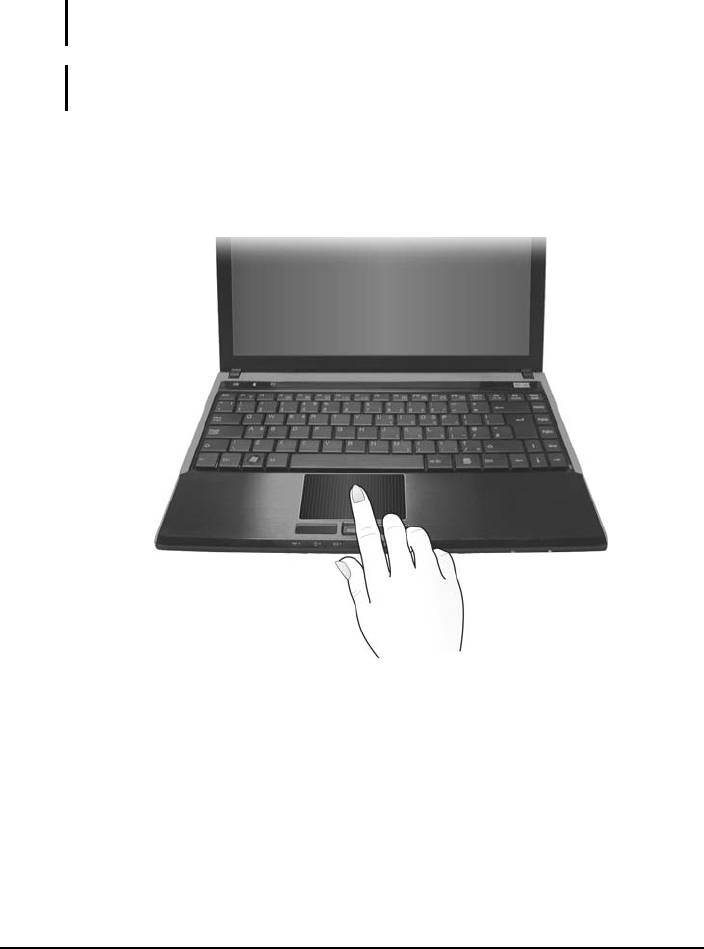
2-12 Operating Your Computer
Using the Touchpad
CAUTION: Do not use a sharp object such as a pen on the touchpad. Doing so may
damage the touchpad surface.
NOTE: For optimal performance of the touchpad, keep your fingers and the pads clean
and dry. When tapping on the pad, tap lightly. Do not use excessive force.
The touchpad is a pointing device that allows you to communicate with
the computer by controlling the location of the pointer on the screen and
making selection with the buttons.
The touchpad consists of a rectangular pad and a left and right buttons. To
use the touchpad, place your forefinger or thumb on the pad. The
rectangular pad acts like a miniature duplicate of your display. As you
slide your fingertip across the pad, the pointer (also called cursor) on the
screen moves accordingly. When your finger reaches the edge of the pad,
simply relocate yourself by lifting the finger and placing it on the other
side of the pad.

Operating Your Computer 2-13
Here are some common terms that you should know when using the
touchpad:
Term Action
Point Move your finger on the pad until the cursor points to the
selection on the screen.
Click Press and release the left button.
–or–
Tap gently anywhere on the pad.
Double-click Press and release the left button twice in quick succession.
–or–
Tap twice on the pad rapidly.
Drag and
drop
Press and hold the left button, then move your finger until
you reach your destination (drag). Finally, release the
button (drop) when you finish dragging your selection to
the destination. The object will drop into the new location.
–or–
Gently tap twice on the pad and on the second tap, keep
your finger in contact with the pad. Then, move your
finger across the pad to drag the selected object to your
destination. When you lift your finger from the pad, the
selected object will drop into place.
Scroll To scroll is to move up and down or left and right in the
working area on the screen.
To move vertically, place your finger on the right or left
edge of the pad and slide your finger up and down along
the edge. To move horizontally, place your finger on the
top or bottom edge of the pad and slide your finger left and
right.
This function works only after you install the touchpad
driver supplied with the computer and it may not work for
all applications.
TABLE NOTE: If you swap the left and right buttons, “tapping” on the touchpad
as an alternative method of pressing the left button will no longer be valid.

2-14 Operating Your Computer
Configuring the Touchpad
You may want to configure the touchpad to suit your needs. For example,
if you are a left-handed user, you can swap the two buttons so that you can
use the right button as the left button and vice versa. You can also change
the size of the on-screen pointer, the speed of the pointer, and so on.
To configure the touchpad, go to Control Panel Hardware and Sounds
Mouse Properties. However, you can install the touchpad driver
supplied with your computer to take advantage of more powerful
features. (For information on installing the driver, see “How to Use the
Driver Disc” in Chapter 6.)
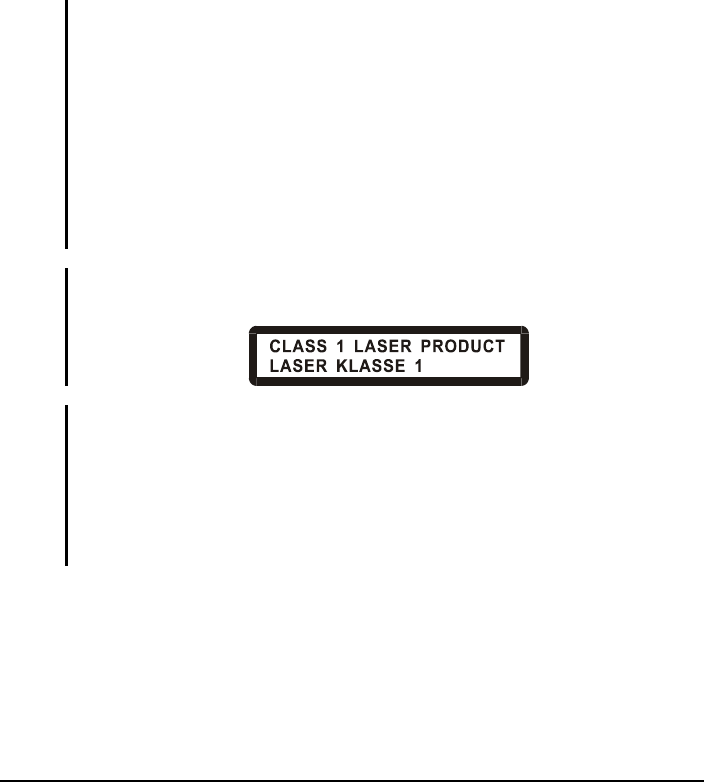
Operating Your Computer 2-15
Using the DVD Drive (Optional)
Depending on the model your computer’s swappable bay may contain a
DVD drive, usually configured as drive D. The Super Multi drive can
work both as a DVD-ROM drive for reading DVD (Digital Versatile
Disc) discs in addition to CDs, audio CDs and CD-R/-RW discs, and
CD-RW drive. Can also write to DVD+R/+RW/-R/-RW/DVD-RAM
discs.
CAUTION:
When inserting a disc, do not use force.
Make sure that the disc is correctly inserted into the tray, and then close the tray.
Do not leave the DVD tray open. Also, avoid touching the lens in the tray with your
hand. If the lens becomes dirty, the DVD drive may malfunction.
Do not wipe the lens using materials with rough surface (such as paper towel).
Instead, use a cotton swab to gently wipe the lens.
FDA regulations require the following statement for all laser-based devices:
“Caution, Use of controls or adjustments or performance of procedures other than
those specified herein may result in hazardous radiation exposure.”
NOTE: The DVD drive is classified as a Class 1 laser product. This label is located on
the DVD drive.
NOTE: For DVD and Combo drives only.
This product incorporates copyright protection technology that is protected by method
claims of certain U.S. patents and other intellectual property rights owned by
Macrovision Corporation and other rights owners. Use of this copyright protection
technology must be authorized by Macrovision Corporation, and is intended for home
and other limited viewing uses only unless otherwise authorized by Macrovision
Corporation. Reverse engineering or disassembly is prohibited.
Inserting and Removing a Disc
Follow this procedure to insert or remove a disc:
1. Turn on the computer.
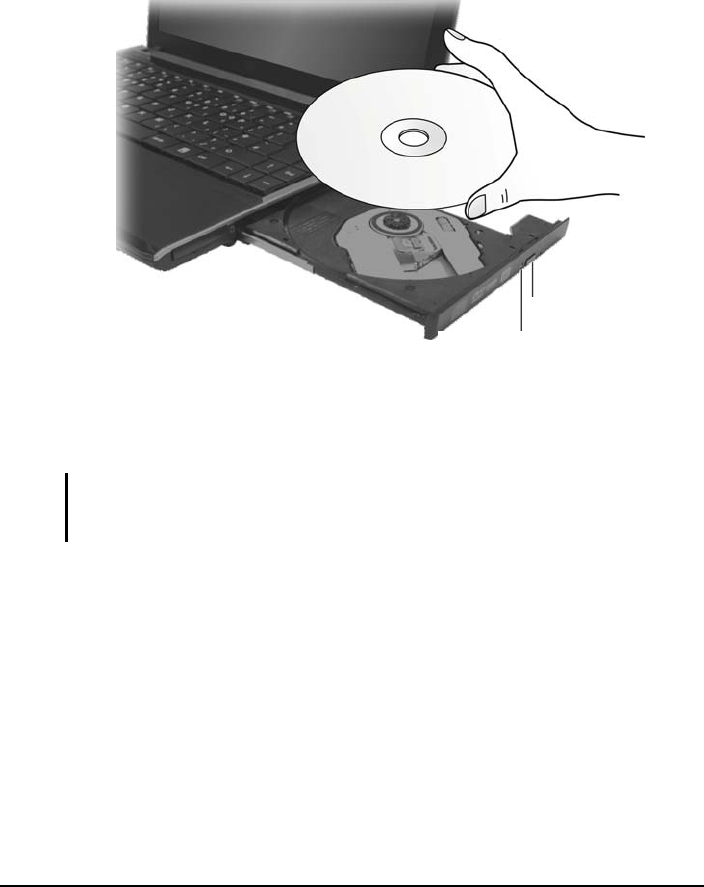
2-16 Operating Your Computer
2. Press the eject button and the DVD tray will slide out partially.
Gently pull on it until it is fully extended.
3. To insert a disc, place down the disc in the tray with its label facing
up. Slightly press the center of the disc until it clicks into place.
To remove a disc, hold the disc by its outer edge and lift it up from the
tray.
4. Gently push the tray back into the drive.
NOTE: In the unlikely event that you are unable to release the DVD tray by pressing the
eject button, you can manually release the disc. (See “Optical Drive Problems” in
Chapter 8.)
In-use indicator
Eject button
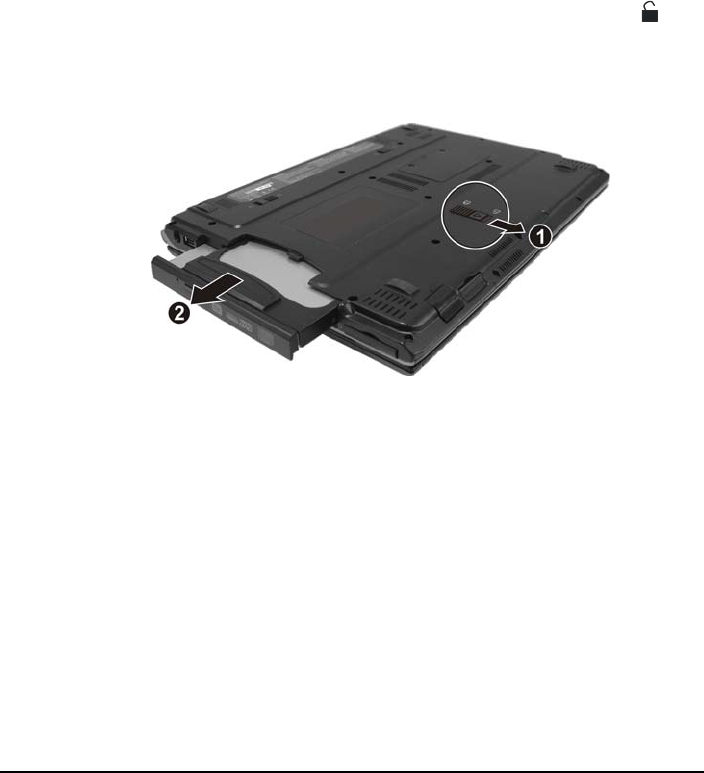
Operating Your Computer 2-17
Installing an Optical Drive Dummy (Optional)
You can install an optical drive dummy in place of the optical drive if you
do not plan to use it for a length of time or to lighten the computer during
transport. To install an optical drive dummy:
1. Make sure that system power is off.
2. Gently place the computer upside down.
3. Slide the swappable bay release lever outward to the unlock ( )
position () and, while holding it in the unlock position, pull the
optical drive off the computer ().
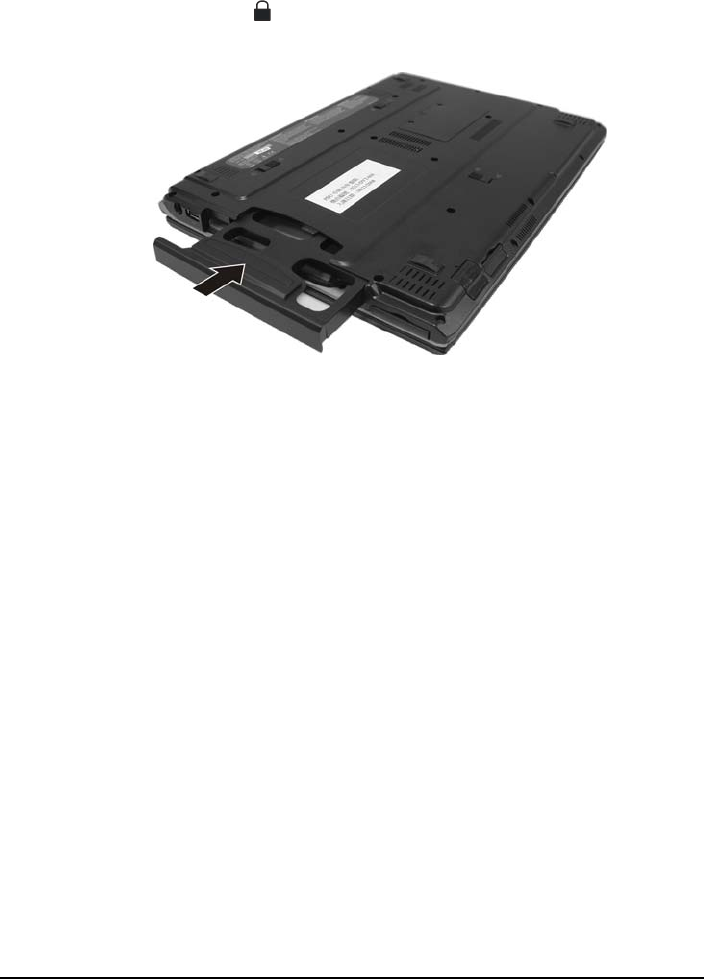
2-18 Operating Your Computer
4. Slide the optical drive dummy all the way into the slot. Make sure to
observe the correct orientation. The swappable bay security lock will
slide to the lock ( ) position to secure the optical drive dummy.

Operating Your Computer 2-19
Using the Video Features
The video subsystem of your computer features:
13.3-inch TFT (Thin-Film Transistor) color LCD display with
1280×800 WXGA resolution
Simultaneous display on LCD and external display, which is useful
when you have a presentation as you can control the screen from your
computer and face the audience at the same time.
Multi-display capability, which allows you to expand your desktop
on the screen to another display device so that you have more desktop
space to work on.
Power Management
NOTE:
Before using the multi-display capability or taking advantage of the enhanced video
capabilities, the VGA driver supplied with your computer must be installed. (See
chapter 6 for details.)
The computer enters the Sleep or Hibernation mode when the LCD is closed.
If you want to use the computer with the LCD closed, set Do Nothing to the “When I
Close the lid” option in the Power Options System Settings Properties.
Thus the computer does not enter the Sleep or Hibernation mode when the LCD is
closed.
Configuring the Display Modes
NOTE: When using an external CRT monitor, the resolution depends on the CRT
monitor’s supported resolution.
Your computer has been set to a default resolution and number of colors
before shipment. You can view and change display settings through your
operating system. See your operating system documentation or online
help for specific information.
For displaying in higher resolutions, you can connect an external monitor
that supports higher resolutions. (See “Connecting an External Monitor”
in Chapter 4 for more information.)
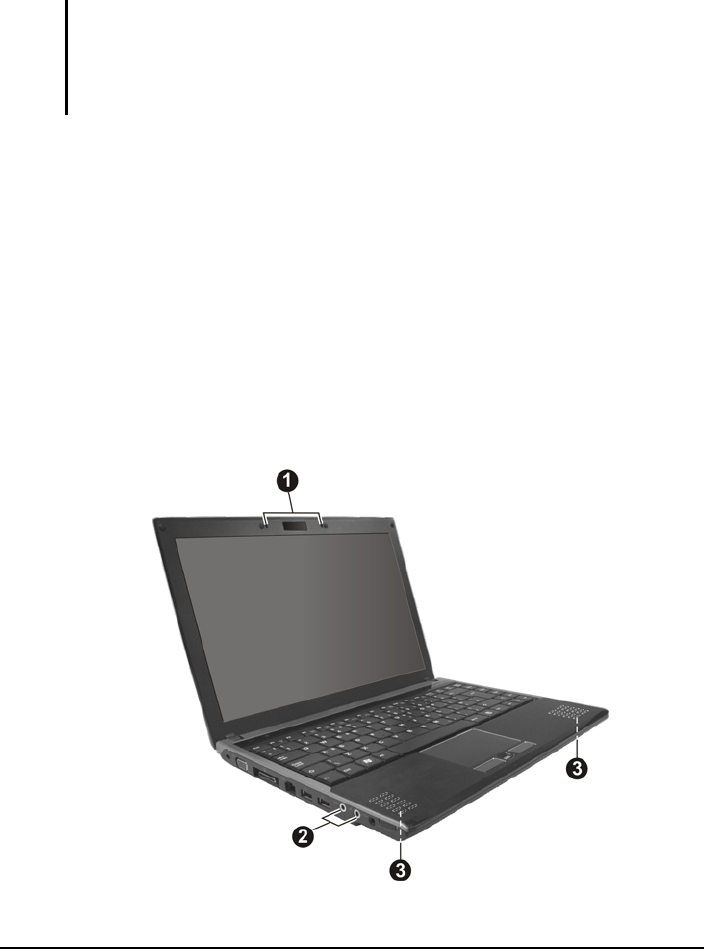
2-20 Operating Your Computer
Using the Audio Features
NOTE:
To take advantage of the enhanced audio capabilities, the audio driver supplied
with your computer must be installed. (See chapter 6 for details.)
If you experience interference while recording, try lowering the microphone
recording volume.
The audio subsystem of your computer features:
Built-in sound system for recording and playing sound on your
computer
Azalia interface (high density audio codec)
2.1-channel analog output
Built-in microphone ()
External audio connectors (), and
Set of speakers ()
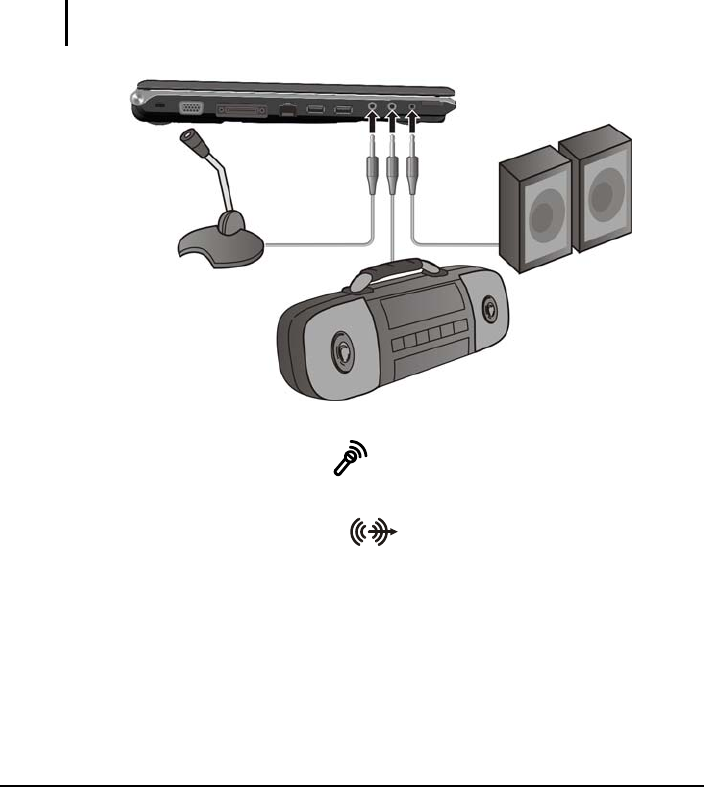
Operating Your Computer 2-21
Ways of playing and recording sound vary with the operating system
used. See your operating system documentation or online help for
specific information.
Connecting Audio Devices
For higher audio quality, you can send or receive sound through external
audio devices.
NOTE: After connecting an external audio device, make sure that you specify the use of
the correct audio device in Windows.
Microphone Connector ( ) can be connected to an external
microphone for recording voice or sound.
Audio Output Connector ( ) can be connected to speakers,
headphones, or earphone set.
S/PDIF Connector ( S/PDIF ) can be connected to the line-in
connector of S/PDIF (Sony/Philips Digital InterFace) compliant as
well as ordinary powered speakers with built-in amplifiers,
headphones, or earphone set. S/PDIF is an audio transfer file format
that ensures a high quality digital audio output through optical fibers.

2-22 Operating Your Computer
NOTE:
The S/PDIF connector is classified as a Class 1 laser product.
When using the external speakers/headphones or microphone, you cannot use the
internal one.
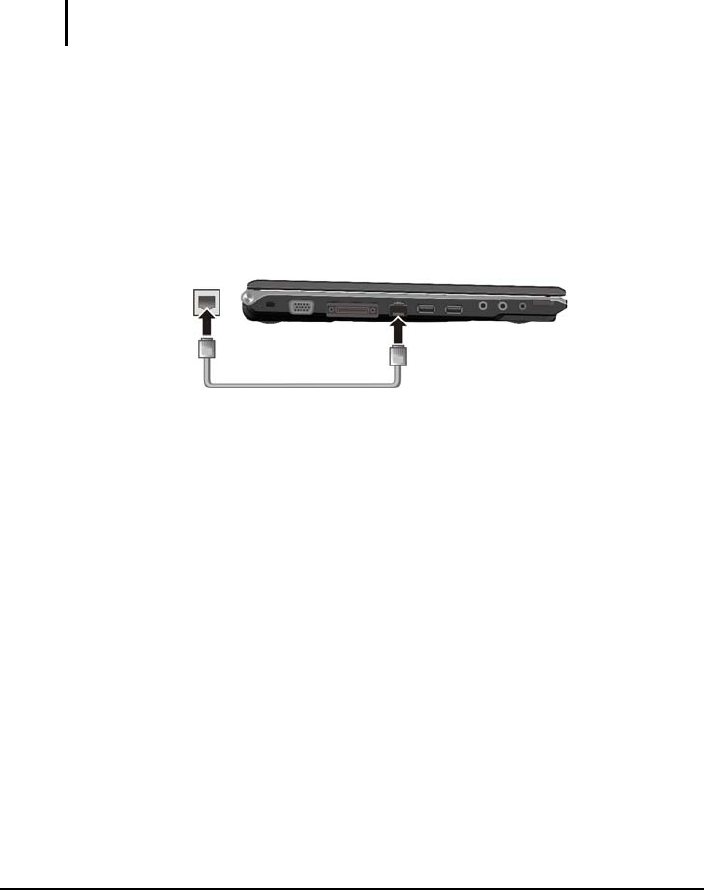
Operating Your Computer 2-23
Using the Communication Features
Using the LAN
NOTE: To take advantage of the LAN feature, the LAN driver supplied with your
computer must be installed. (See chapter 6 for details.)
The internal 10/100/1000Base-T LAN (Local Area Network) module
allows you to connect your computer to a network. It supports data
transfer rate up to 1000 Mbps.
To connect the network cable to the LAN module, connect one end of the
LAN cable to the RJ-45 connector on the computer and the other end to
the network hub.

2-24 Operating Your Computer
Using the Wireless LAN
Depending on your model, an internal mini PCI-E wireless LAN
(WLAN) card may have been pre-installed by your computer
manufacturer at the factory. This card allows you to access corporate
networks or the Internet in a wireless environment.
The WLAN features include:
WEP (Wired Equivalent Privacy) 64/128-bit data encryption
IEEE 802.11a/b/g/n standard compliance
Technology
Stated
Maximum
Throughput
(Mbps)
Data Rates
(Mbps)
Band (GHz)
Modulation Technology
802.11a 54 54, 48, 36,
24, 18, 12,
9, 6
5.15 ~ 5.35 OFDM (Orthogonal Frequency
Division Multiplexing)
802.11b 11 11, 5.5, 2, 1 2.4 DSSS (Direct Sequence Spread
Spectrum)
802.11g 54 54, 36, 18,
9
2.4 OFDM (Orthogonal Frequency
Division Multiplexing)
802.11n 100 Mbps or
more
100 ~ 210 2.4 / 5 Spatial multiplexing, uses MIMO
(multiple-input multiple-output)
To take advantage of the WLAN feature, make sure that the WLAN
driver is installed correctly. (See chapter 6 for details.) If your WLAN
card was provided by your dealer instead of the computer manufacturer,
contact your dealer for the correct driver to use.
Turning Off/On the WLAN Radio
NOTE: The FAA (Federal Aviation Agency) has deemed it unsafe to operate wireless
devices in aircraft as this may interfere with flight safety. Remember to turn off wireless
LAN when using your computer in the airplane.
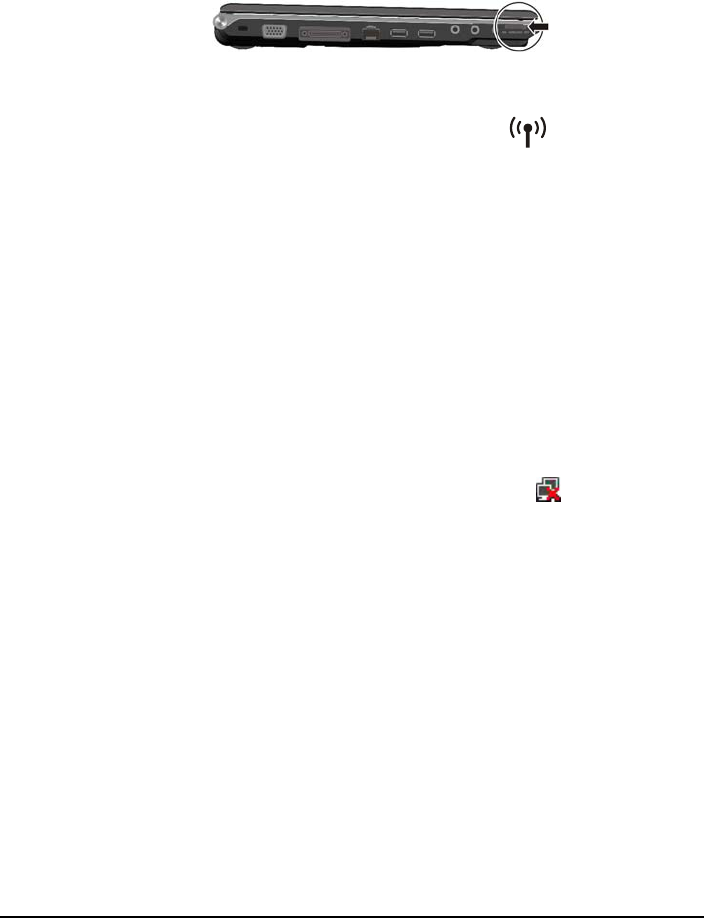
Operating Your Computer 2-25
To turn on the WLAN radio:
1. Make sure that the RF switch is at the ON position.
2. Press
Fn+F1 to turn on the WLAN radio (see “Fn+F1 Behavior” in
Chapter 2), indicated by the WLAN indicator ( ) glowing in blue
when on.
If you need to temporarily turn off the radio, press Fn+F1. To resume
network connection, press Fn+F1 again.
It takes approximately 30 seconds for your computer to make a successful
WLAN connection and approximately 10 seconds to disconnect.
Connecting to a Wireless Network
To connect to a wireless network:
1. Make sure that the WLAN radio is on (see the previous section).
2. Right-click the Wireless Network Connection icon located on the
Windows system tray and select Connect to a network.
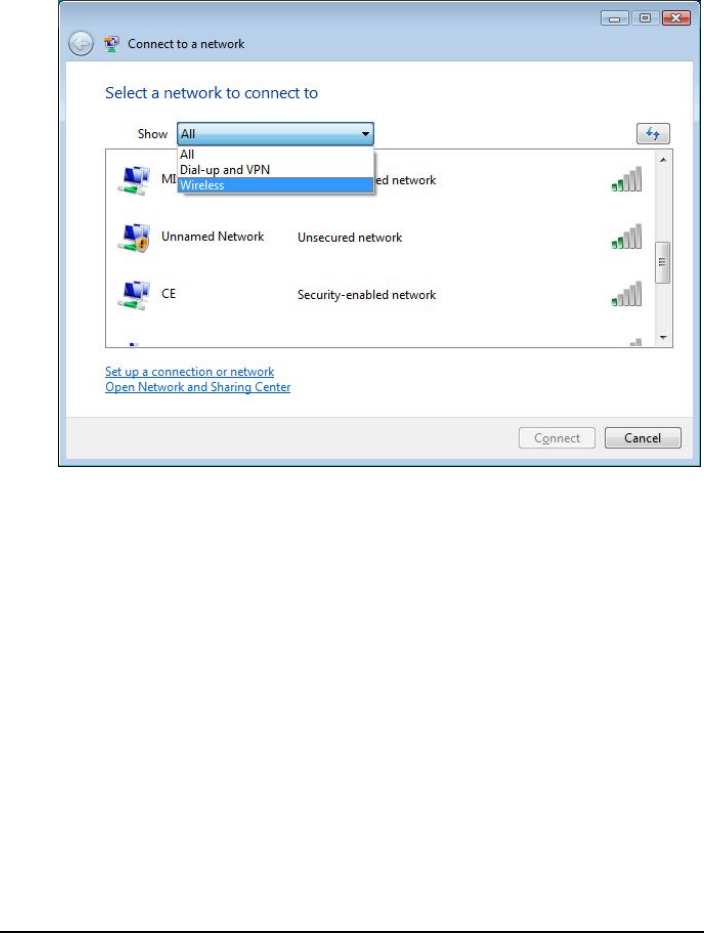
2-26 Operating Your Computer
3. If any wireless network is detected, the following window appears on
screen. Click the Show drop down menu and select Wireless.
4. Select a wireless network to connect to by clicking a selection, then
click Connect.
5. Depending on the settings, you may be asked to enter a WEP key
(refer to your Windows online help for more information on setting a
wireless network connection).
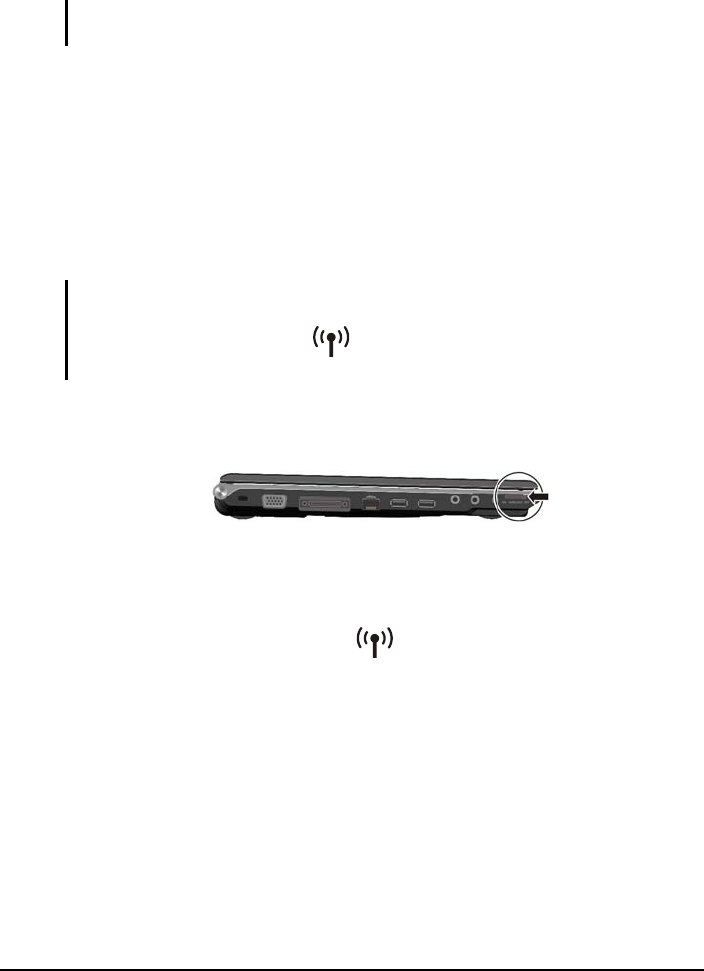
Operating Your Computer 2-27
Using the Bluetooth® Wireless Feature
NOTE: To take advantage of the Bluetooth feature, the Bluetooth driver supplied with
your computer must be installed. (See chapter 6 for details.)
Depending on your model, your computer may incorporate the Bluetooth
capability for short-range (about 10 meters) wireless communications
between devices without requiring a cable connection.
With Bluetooth, data can be transmitted through walls, pockets and
briefcases as long as two devices are within range.
Turning On and Off the Bluetooth Feature
NOTE:
You can still use the WLAN feature when the Bluetooth feature is turned on.
The wireless LAN indicator ( ) will glow in purple when both wireless LAN and
Bluetooth feature are turned on.
1. Make sure that the RF switch is at the ON position.
2. Press
Fn+F1 to turn the Bluetooth® wireless feature on (see “Fn+F1
Behavior” in Chapter 2).
The wireless LAN indicator ( ) will glow in red. By default, your
computer is in the general discoverable and pairable mode after the
Bluetooth feature is turned on.
3. To turn off the Bluetooth feature, press Fn+F1 again.
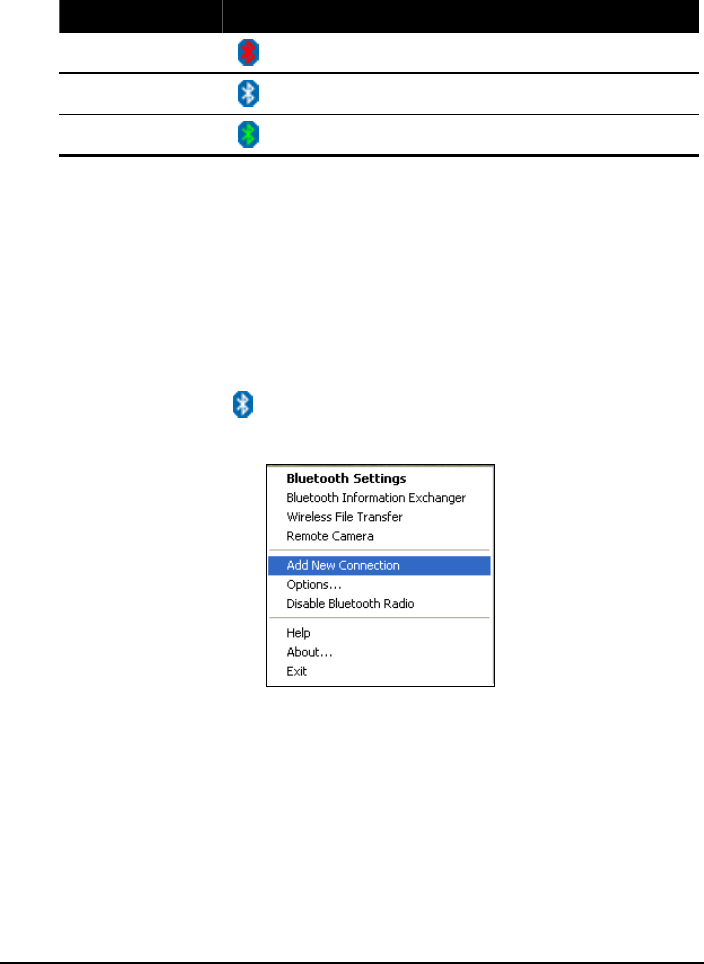
2-28 Operating Your Computer
The status of the Bluetooth connection is indicated by the Bluetooth icon
located in the system tray in the lower-right part of the screen.
Status Icon
Off ® (blue with red logo)
On
® (blue with white logo).
Connected
®
(blue with green logo)
You can use the Bluetooth Utility to configure Bluetooth connection
settings and transfer files.
Connecting to Another Bluetooth Device
1. Make sure that the target Bluetooth device is turned on, discoverable
and within close range. (See the documentation that came with the
Bluetooth device.)
2. Right-click the icon, and then click Add New Connection.
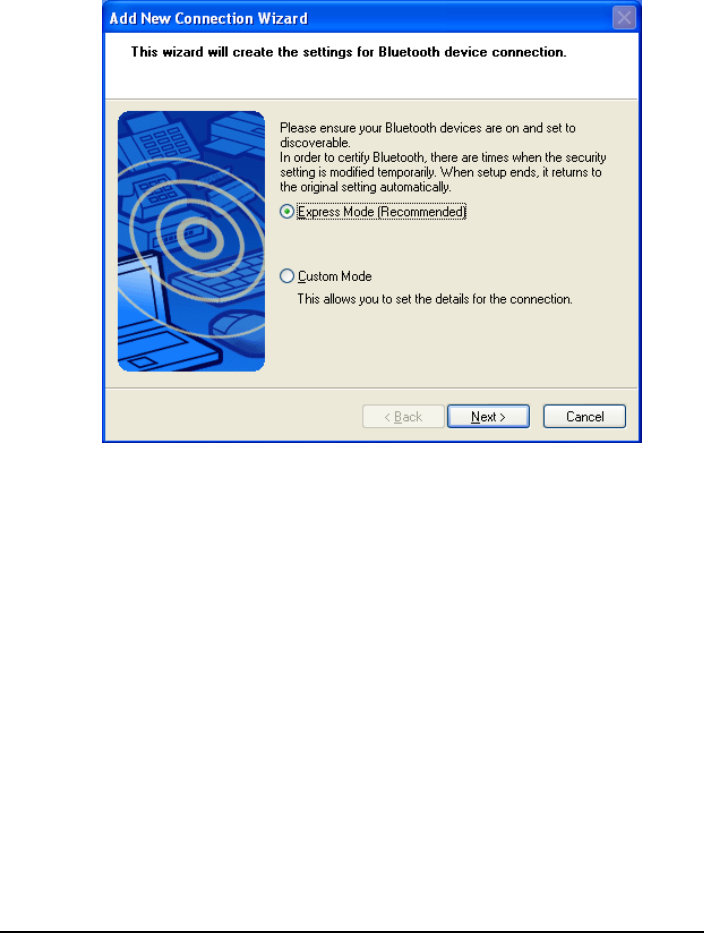
Operating Your Computer 2-29
3. The Add New Connection Wizard window appears. Select Express
Mode (Recommended), then click Next.
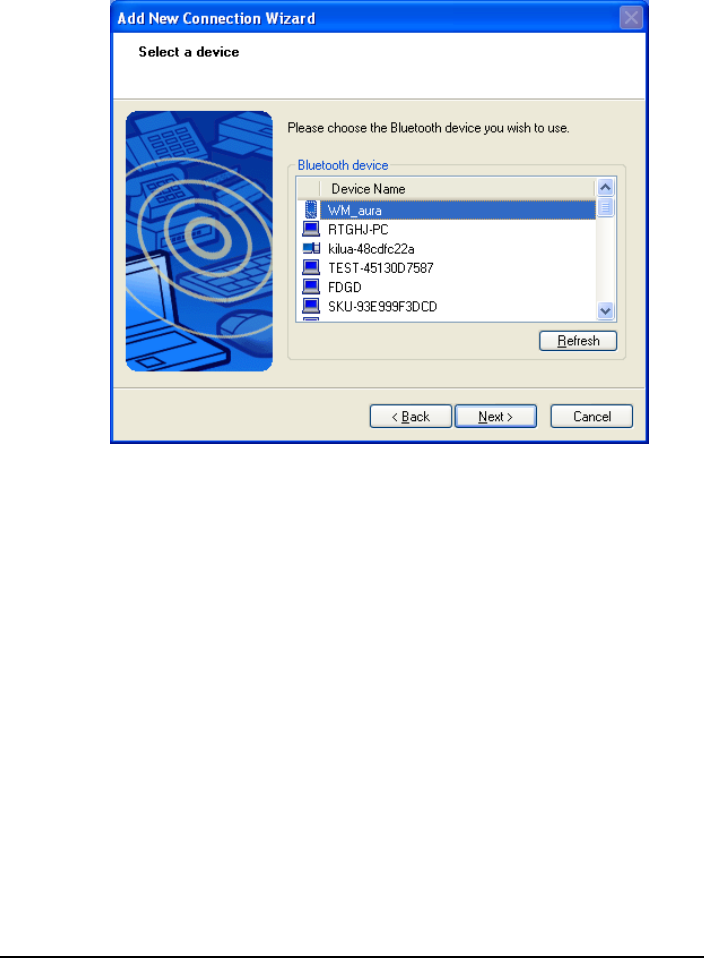
2-30 Operating Your Computer
4. Select the device to connect to and click Next.
5. Depending on the type of Bluetooth device that you want to connect
to, you will need to enter the pertinent information.
For detailed information on using the Bluetooth Utility, see the Bluetooth
Utility Help on your computer by clicking Help, then Contents and Index.
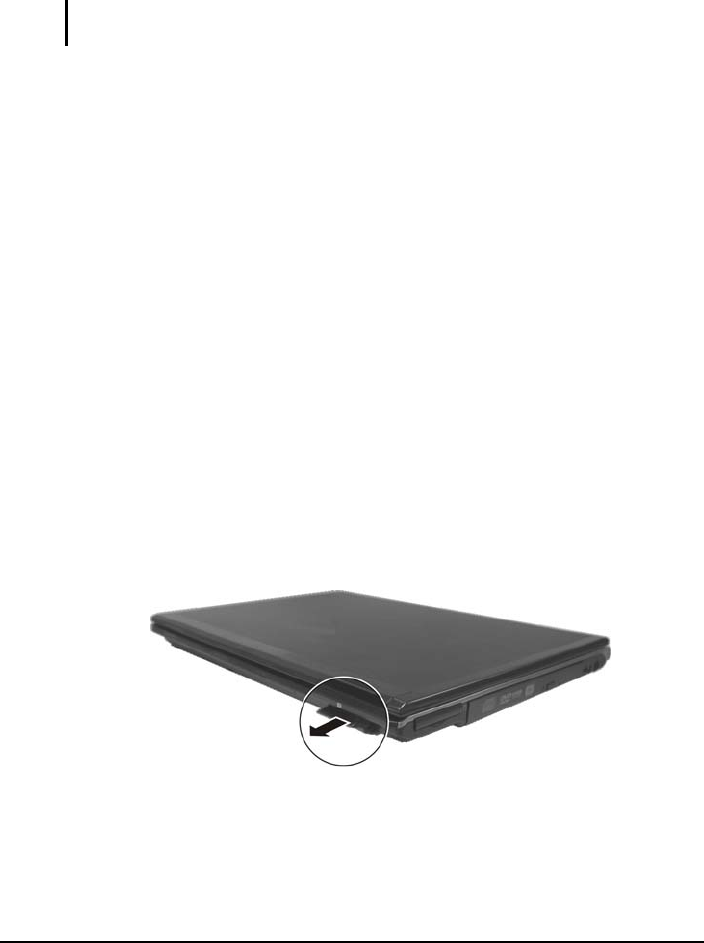
Operating Your Computer 2-31
Using the 3G Feature (Optional)
NOTE: To take advantage of the 3G feature, the 3G driver supplied with your computer
must be installed. (See chapter 6 for details.)
3G is the third generation of mobile phone standards and technology,
after 2G. It is based on the International Telecommunication Union (ITU)
family of standards under the International Mobile Telecommunications
programme, “IMT-2000”. Services include wide-area wireless voice
telephony and broadband wireless data, all in a mobile environment.
Unlike IEEE 802.11 networks, 3G networks are wide area cellular
telephone networks which evolved to incorporate high-speed internet
access and video telephony. IEEE 802.11 networks are short range,
high-bandwidth networks primarily developed for data.
To use the 3G feature on your computer, you need to subscribe to 3G
service and install the 3G SIM card from your service provider, network
operator, or other vendor.
To install the SIM card, follow these steps:
1. Make sure that the computer is not turned on or connected to AC
power.
2. Remove the SIM card slot cover.
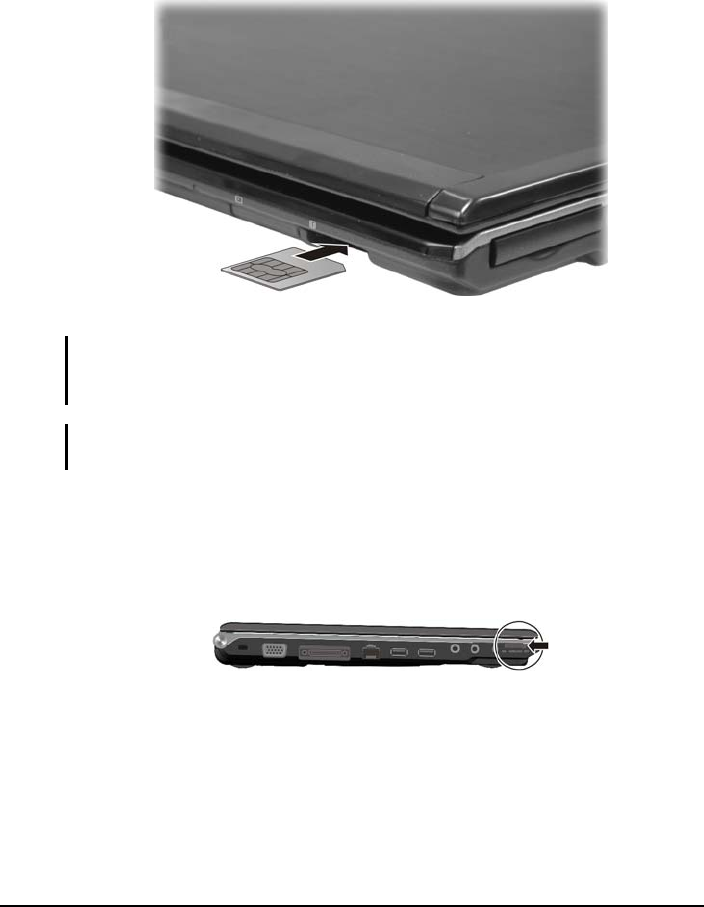
2-32 Operating Your Computer
3. Insert the SIM card into the holder. Make sure the beveled corner on
the SIM card is facing towards the computer and that the golden
contact area on the card is facing upwards.
WARNING: Keep all SIM cards out of the reach of small children. For availability and
information on using SIM card services, contact your SIM card vendor. This may be the
service provider, network operator, or other vendor.
NOTE: To remove the SIM card, push inward to release and slide the SIM card out of
the slot.
Turning On and Off the 3G Feature
1. Make sure that the RF switch is at the ON position.
2. Press
Fn+F1 to turn the 3G feature on (see “Fn+F1 Behavior” in
Chapter 2).
3. To turn off the 3G feature, press Fn+F1 again.
You can use the 3G software application to configure 3G connection
settings.
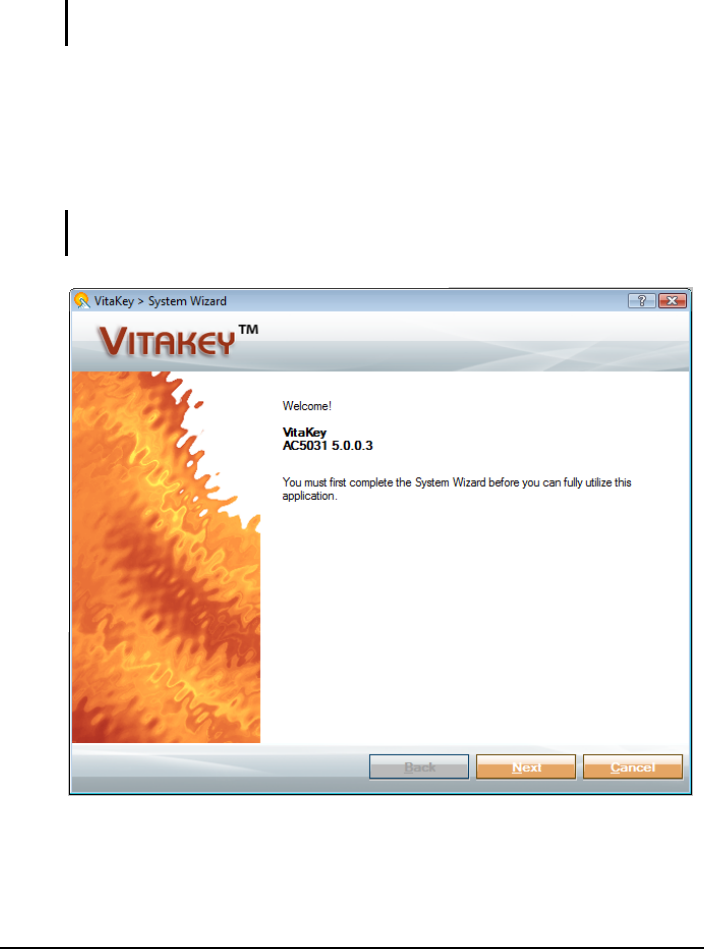
Operating Your Computer 2-33
Using the Fingerprint Sensor
NOTE: To take advantage of the fingerprint sensor, the fingerprint driver supplied with
your computer must be installed. (See chapter 6 for details.)
To start using the fingerprint sensor:
1. Locate the fingerprint sensor.
2. Go to Start menu All Programs VitaKey AC5031 System
System Settings.
NOTE: You must first complete the System Wizard before you can utilize the VitaKey
utlity. The following screen appears.
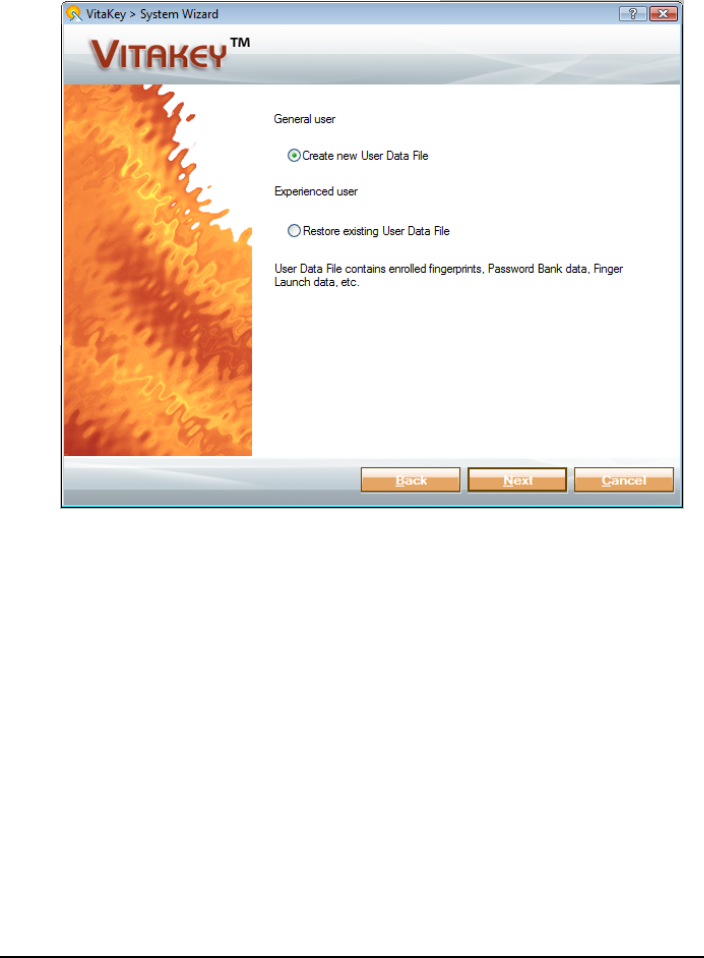
2-34 Operating Your Computer
3. Click Next to continue and the following screen appears.
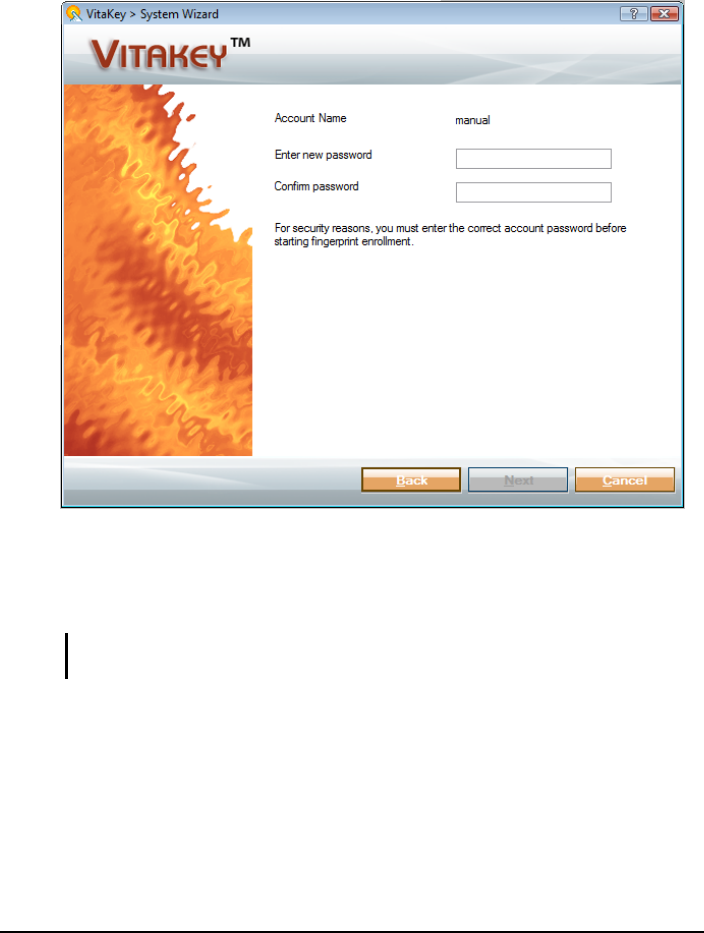
Operating Your Computer 2-35
4. Select Create new user data file and click Next to continue. The
following screen appears.
5. Enter the password twice and click Next to continue. Follow the
onscreen instructions to complete the System Wizard.
NOTE: For an online Help information on using the VitaKey utility, you can go to Start
menu All Programs VitaKey AC5031 Online Help.

Managing Power 3-1
Chapter 3
Managing Power
Your computer operates either on external AC power or on internal
battery power.
This chapter tells you how you can effectively manage power. To
maintain optimal battery performance, it is important that you use the
battery in the proper way.
The topics in this chapter include:
What is an AC adapter
How to charge the battery pack
When and how to initialize the battery pack
How to check the battery level
How to replace the battery pack
What happens when the battery is low and what actions to take
What is Power Management
How to save power
CHAPTER
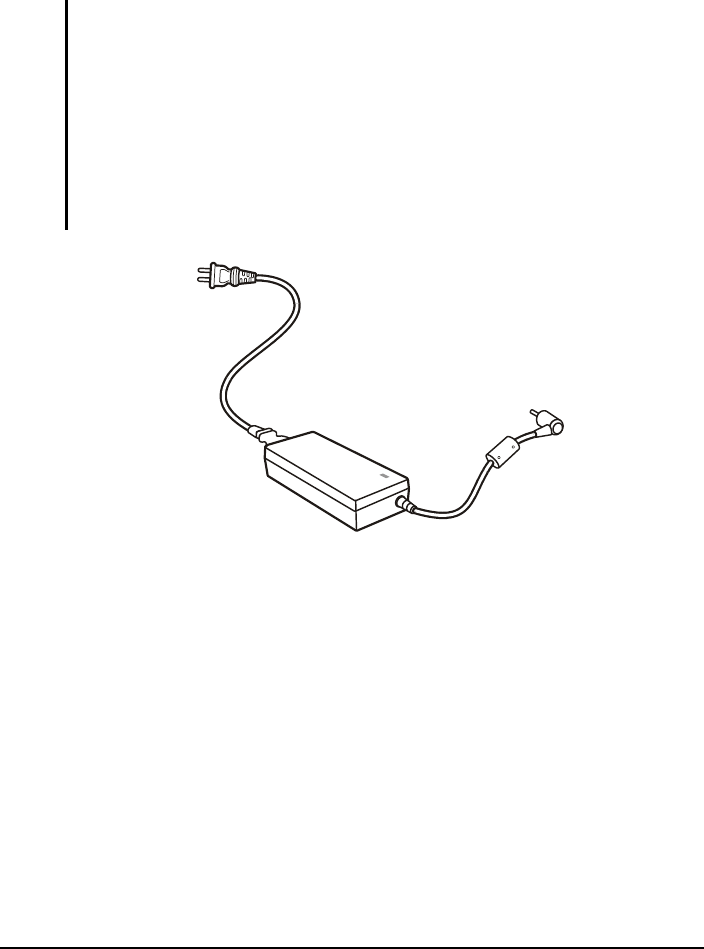
3-2 Managing Power
AC Adapter
CAUTION:
The AC adapter is designed for use with your computer only. Connecting the AC
adapter to another device can damage the adapter.
The AC power cord supplied with your computer is for use in the country where you
purchased your computer. If you plan to go overseas with the computer, consult
your dealer for the appropriate power cord.
When you disconnect the AC adapter, disconnect from the electrical outlet first and
then from the computer. A reverse procedure may damage the AC adapter or
computer.
When unplugging the connector, always hold the plug head. Never pull on the cord.
The AC adapter serves as a converter from AC (Alternating Current) to
DC (Direct Current) power because your computer runs on DC power,
but an electrical outlet usually provides AC power. It also charges the
battery pack when connected to AC power.
The adapter operates on any voltage in the range of 100~240 V AC.

Managing Power 3-3
Battery Pack
The battery pack is the internal power source for the computer. It is
rechargeable using the AC adapter.
The operating time of a fully charged battery pack depends on how you
are using the computer. When your applications often access peripherals,
you will experience a shorter operating time.
NOTE: Care and maintenance information for the battery is provided in the “Battery
Pack Guidelines” section in Chapter 7.
Charging the Battery Pack
NOTE:
Charging will not start if the battery’s temperature is below 0 °C (32 °F) or above
45 °C (113 °F).
The charging process will stop and the Battery Charge Indicator flashes red when
the battery’s temperature gets above 60 °C (140 °F). If this happens, the battery
pack may be damaged. Please contact your dealer.
During charging, do not disconnect the AC adapter before the battery has been fully
charged; otherwise you will get a prematurely charged battery.
To charge the battery pack, connect the AC adapter to the computer and
an electrical outlet. The Battery Charge Indicator ( ) on the
computer glows amber to indicate that charging is in progress. You are
advised to keep the computer power off while the battery is being
charged. When the battery is fully charged, the Battery Charge Indicator
is off.

3-4 Managing Power
The charging times are as follows:
Charging Time
Battery Type Computer is Off Computer is On and
in Idle State
3-cell
(2600 mAH)
3 hours 3.5 hours
6-cell
(5200 mAH)
4 hours 4.5 hours
Second battery pack
(in swappable bay)
3.5 hours 4 hours
CAUTION: After the computer has been fully recharged, do not immediately disconnect
and reconnect the AC adapter to charge it again. Doing so may damage the battery.
NOTE: The battery level may automatically lessen due to the self-discharge process
(0.21 % per day), even when the battery pack is fully charged (100 %). This happens no
matter if the battery pack is installed in the computer.
Initializing the Battery Pack
You need to initialize a new battery pack before using it for the first time
or when the actual operating time of a battery pack is much less than
expected.
Initializing is the process of fully charging, discharging, and then
charging. It can take several hours.
1. Make sure that the computer power is turned off. Connect the AC
adapter to fully charge the battery pack.
2. After the battery pack is fully charged, turn on the computer. When
the message “Press F2 for System Utilities” appears, press
the F2 key to invoke the program.
3. Disconnect the AC adapter and leave the computer on until the
battery is fully discharged. The computer will shut down
automatically.
4. Connect the AC adapter to fully charge the battery pack.
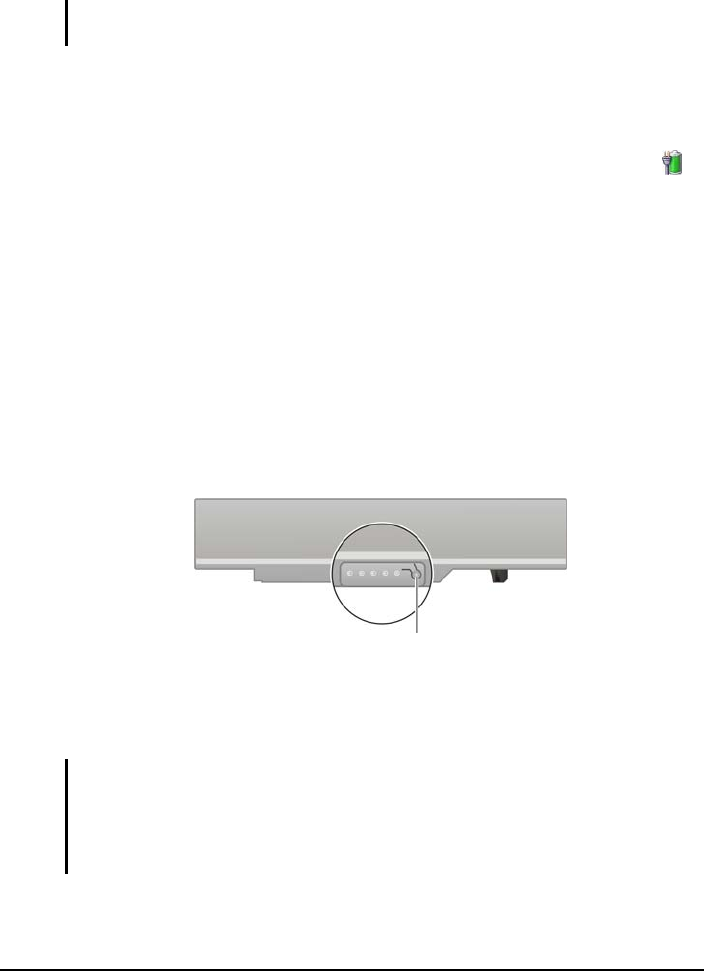
Managing Power 3-5
Checking the Battery Level
NOTE: Any battery level indication is an estimated result. The actual operating time can
be different from the estimated time, depending on how you are using the computer.
By Operating System
You can check the approximate battery level using the battery meter
function of the operating system. To read the battery level, click the
icon on the system tray.
By Gas Gauge
On the exterior side of the battery pack is a gas gauge for displaying the
estimated battery charge. When the battery pack is not installed in the
computer and you want to know the battery charge, you can press the
switch with a pointed device to see the corresponding value of indicator
segment that light green. The value of the corresponding green segment
indicates the relative percentage of the battery charge. The battery pack is
fully discharged when you see no segment glowing green.
Replacing the Battery Pack
CAUTION:
There is danger of explosion if the battery is incorrectly replaced. Replace the
battery only with the computer manufacturer’s optional battery packs. Discard used
batteries according to the dealer’s instructions.
Do not attempt to disassemble the battery pack.
Switch
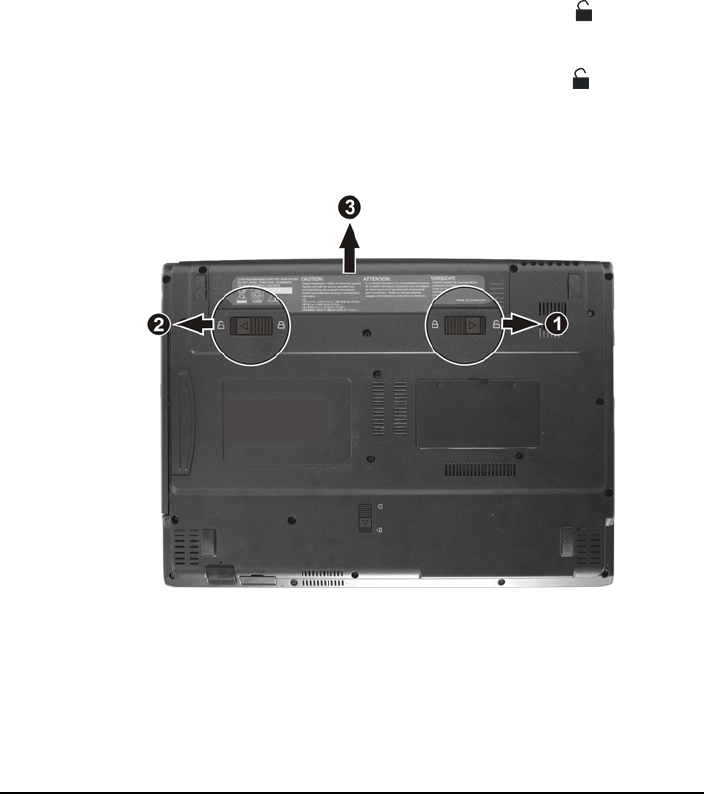
3-6 Managing Power
If you often rely on battery power for a long period of time while
traveling, you may consider the purchase of an additional battery pack
from your dealer and keep it with you in a fully charged state as a backup.
To replace the battery pack, follow these steps:
1. Make sure that the computer is not turned on or connected to AC
power.
2. Place the computer upside down.
3. Slide the battery security lock outward to the unlock ( ) position
().
4. Slide the battery release lever outward to the unlock ( ) position
() and, while holding it in the unlock position, remove the battery
pack off the computer ().
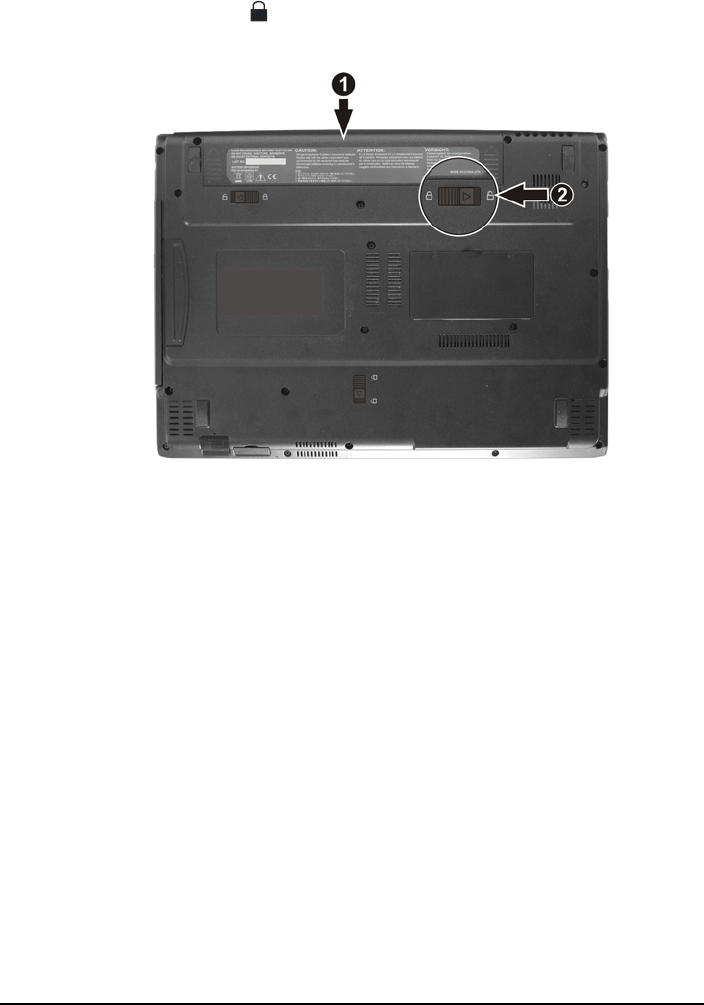
Managing Power 3-7
5. Fit another battery pack into place () and slide the battery security
lock to the lock ( ) position ().
Installing a Second Battery Pack (Optional)
You can install a second battery pack to your computer for a longer
operating time when AC power is not available. To install a second
battery pack:
1. Make sure that system power is off.
2. Gently place the computer upside down.
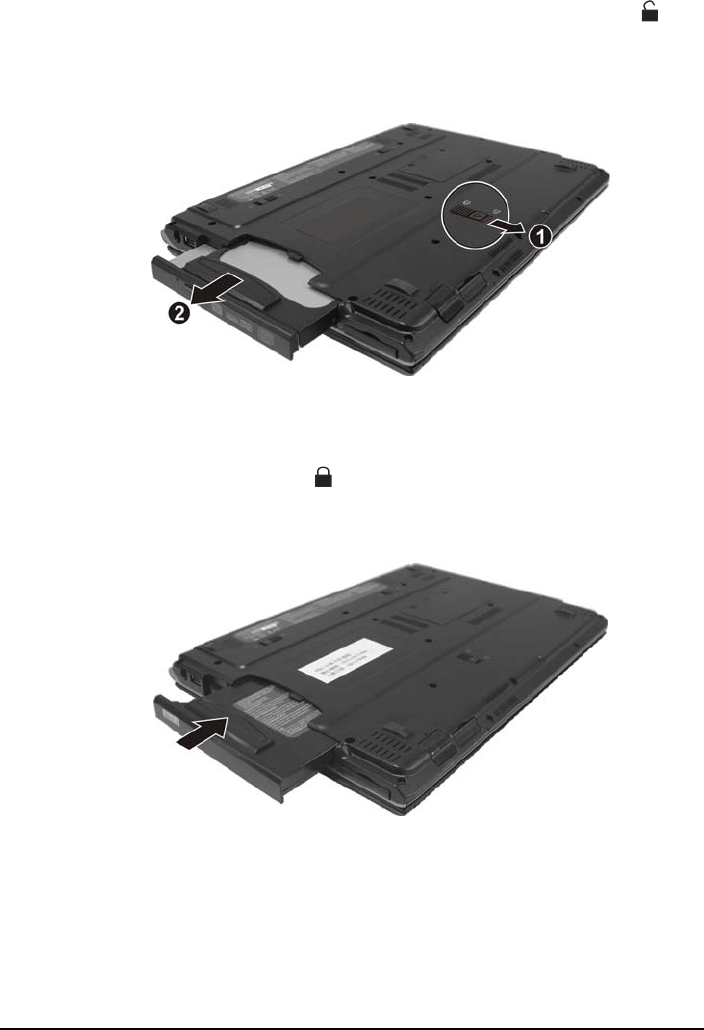
3-8 Managing Power
3. Slide the swappable bay release lever outward to the unlock ( )
position () and, while holding it in the unlock position, pull the
optical drive off the computer ().
4. Slide the second battery pack all the way into the slot. Make sure to
observe the correct orientation. The swappable bay security lock
would slide to the lock ( ) position to secure the second battery
pack.

Managing Power 3-9
Battery Low Signals and Actions
The battery icon changes appearance to display the current state of the
battery so that you can see how much charge remains (Windows default
setting). When the battery charge is above 25 % the battery icon is green.
When the battery charge reaches 25 % a yellow triangle with an
exclamation point (!) appears above the green battery icon. When the
charge reaches the low battery level a red circle with a white “X” appears
above the green icon. The computer’s Battery Charge Indicator ( )
blinks red to alert you to take actions.
Immediately save your data upon Battery Low. The remaining operating
time depends on how you are using the computer. If you are using the
audio subsystem, ExpressCard, hard or USB flash disk, the battery might
run out of charge very quickly.
Always respond to Battery Low by placing your computer on Hibernation
mode, turning off the computer, or connecting the AC adapter.
CAUTION:
If you are using an ExpressCard, do not access the card during battery low periods.
This is because the access may take longer than the time it takes the battery to run
out of charge, thus making your access to the card unsuccessful.
If you fail to save your data when the battery completely runs out of charge, then
you lose your data.

3-10 Managing Power
Power Management
Your computer supports ACPI (Advanced Configuration and Power
Interface) for power management. The power management feature allows
you to reduce the power consumption for energy saving.
With an ACPI-compliant operating system such as Windows, power
supply to different computer components is controlled on an as-needed
basis. This allows maximum power conservation and performance at the
same time.
In general, Windows’ power management works in this way:
What... When...
Power to the hard disk is turned off When the hard disk has been idle for a
set period.
Power to the display is turned off When the display has been idle for a
set period.
When the entire system has been idle
for a set period.
When you press the Fn+F12 hot key. *
When you close the cover. *
The computer enters the Sleep mode.
The hard disk and display are turned
off and the entire system consumes
less power.
When you press the power button. *
When the entire system has been idle
for a set period.
When you press the Fn+F12 hot key. *
When you close the cover. *
The computer enters the Hibernation
mode. (See the next subsection for
more information.)
When you press the power button. *
* Depends on your settings in Windows.
For detailed information on power management, see Windows’ Help.